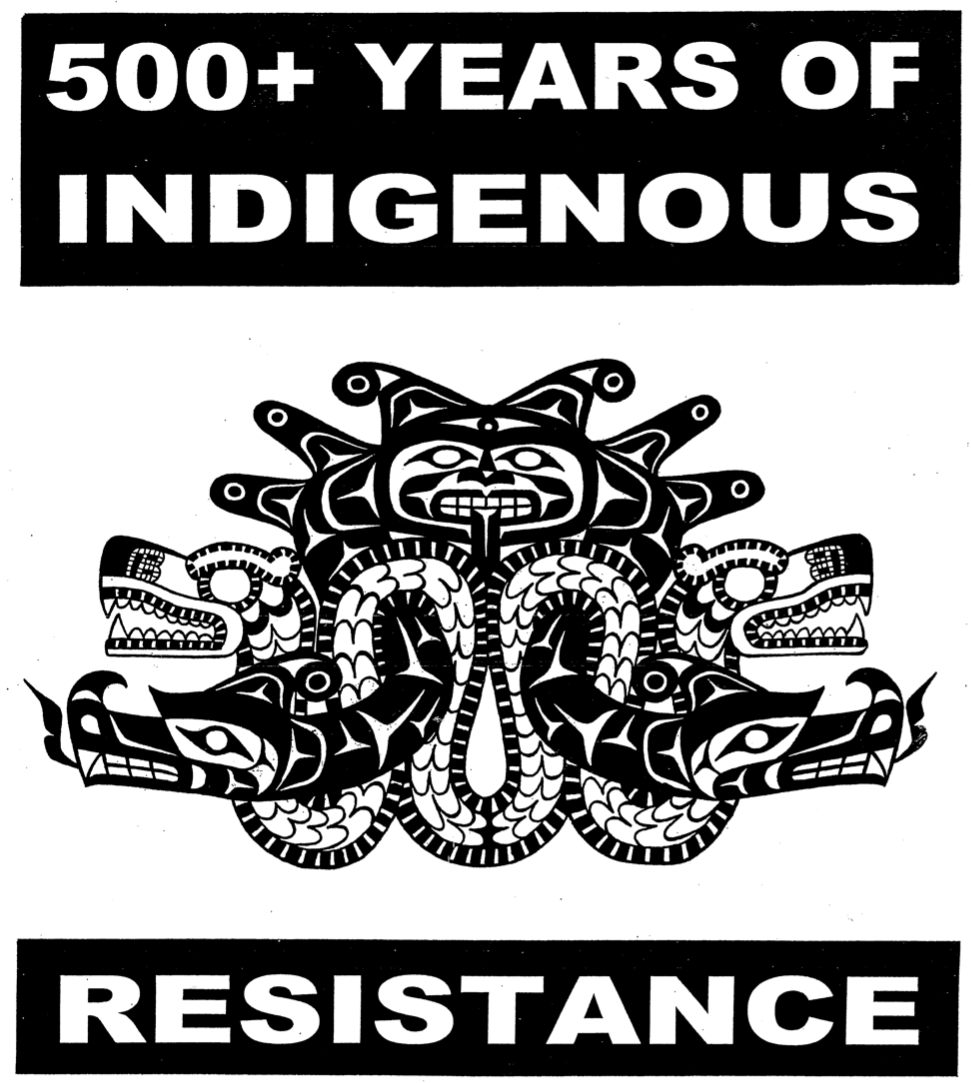Colonization and Decolonization - A Manual for Indigenous Liberation in the 21st Century
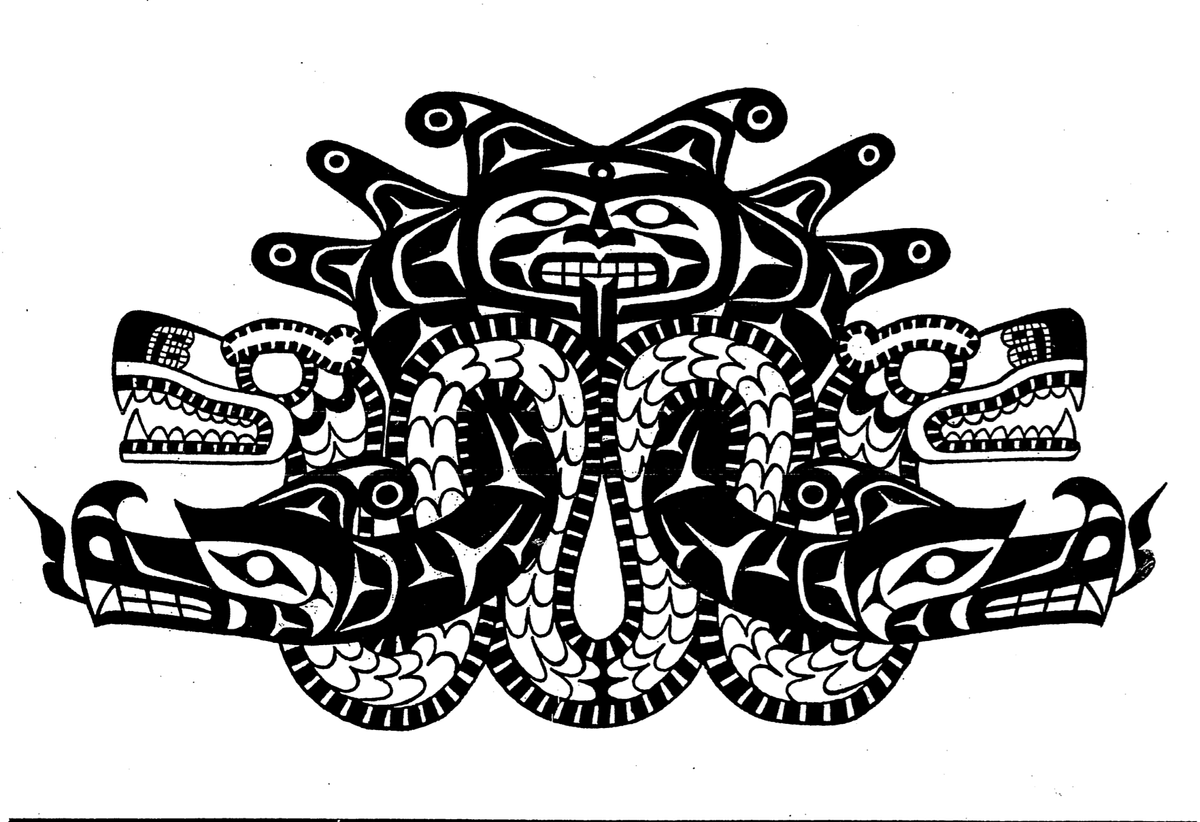
This is an online version of the Colonization and Decolonization Manual written and illustrated by Gord Hill (Kwakwaka’wakw nation), who frequently writes under the pseudonym Zig Zag.
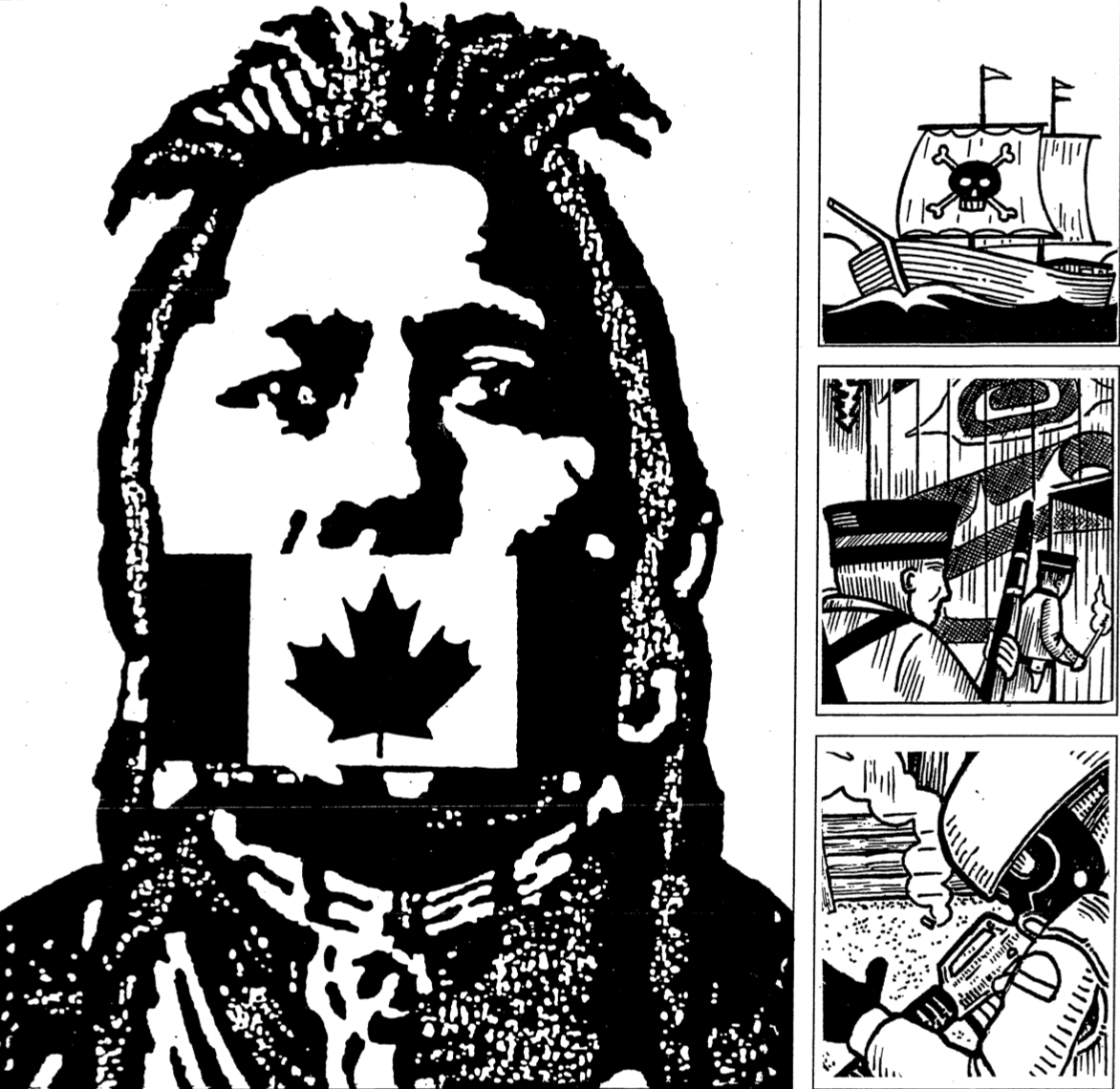
How to Use This Manual
This manual is divided into four sections. The first section defines colonialism, its methods, & its history up to today (i.e.,the US invasion & occupation of Iraq). The second section details the impact colonialism has had on Indigenous peoples, including sociological & individual impacts. The third section examines the concept of decolonization. The fourth section discusses decolonization within North America. It will be seen that the liberation of Indigenous peoples in North America is closely-connected to a global process of resistance & survival. This manual is intended for self-study as well as for use in training classes. The following are lesson plans that can be used or adapted for the classroom.
3 Classes Total
Sections 1 & 2 can be held as separate 45 minute to 1 hour classes; the 3rd & 4th sections on Decolonization can be presented as one 1 hour class.
Total: 3 classes at 1 hour each: 3 hours.
Training Aids
- 1st Class: maps of world, flip- chart/board, graphic poster-boards, video clips of events/news.
- 2nd Class: flip-chart/board, graphic poster-boards, video clips.
- 3rd Class: flip-chart/board, graphic poster-boards, video clips, Warrior Unity flag, large map of North America.
Training Tips
- Be motivated & enthusiastic: use graphic training aids. History & colonialism can be hard subjects to teach. Instructors must strive to make it interesting, inspiring & relevant to student.
- Know your subject. This material can-be difficult to present. Study & prepare. Emphasize important points and concepts.
- Use intro, body, & conclusion (tell them what you're gonna tell them, tell 'them, tell 'em what you told 'em).
- If practical, hold classes consecutively (3 in a row, with 10-15 min. breaks).
For presentations, contact: zig_zag48(at)hotmail.com
"Knowledge makes a person unfit to be a slave."
-- Frederick Douglas
Lesson Plans
- Introduction & History
- Define Colonialism, 4 Stages of Colonialism.
- History of Colonialism.
- Egyptian
- European
- Roman
- 1492: Invasion of Americas, 1498 North America
- Revolts; Settler & Afrikan
- Final Phase North America
- 1890 Africa, Asia & the Middle-East War & the Rise of USA
- World War 2 & UN 'Decolonization'
- Vietnam/US Domestic Unrest New World Order-War for Oil
- Conclusion
- Impacts of Colonialism
- European Settler Society
- Settler-Nations
- Imperialism
- Apartheid
- White Supremacy
- Patriarchy
- Neo-colonialism
- Pyramid of Power/Social Structure
- Sociological Impact
- Genocide
- Loss of Sovereignty & Territory
- Assimilation
- Individual Impact
- Post-Traumatic Stress Disorder
- Individualism, Identity, Inferiority
- Internal Violence
- Alchohol, Drugs, Suicide
- Conclusion
- European Settler Society
- Decolonization
- Culture
- Warrior Culture/Fighting Spirit
- Identifying the Common Enemy
- Disengaging from Colonial System
- Liberation of Mind & Spirit
- Active Use of Territory
- Decolonization in North America
- Decline of Roman/USSR/USA
- USA: An Empire Divided
- Mexico & US Southwest
- Insurgency in Iraq
- Crises, Conflict & Resistance
- Bibliograpy
- Appendix A: UN Declaration of Decolonization
- Appendix B: Excerpts from: 1948 United Nations Genocide Convention
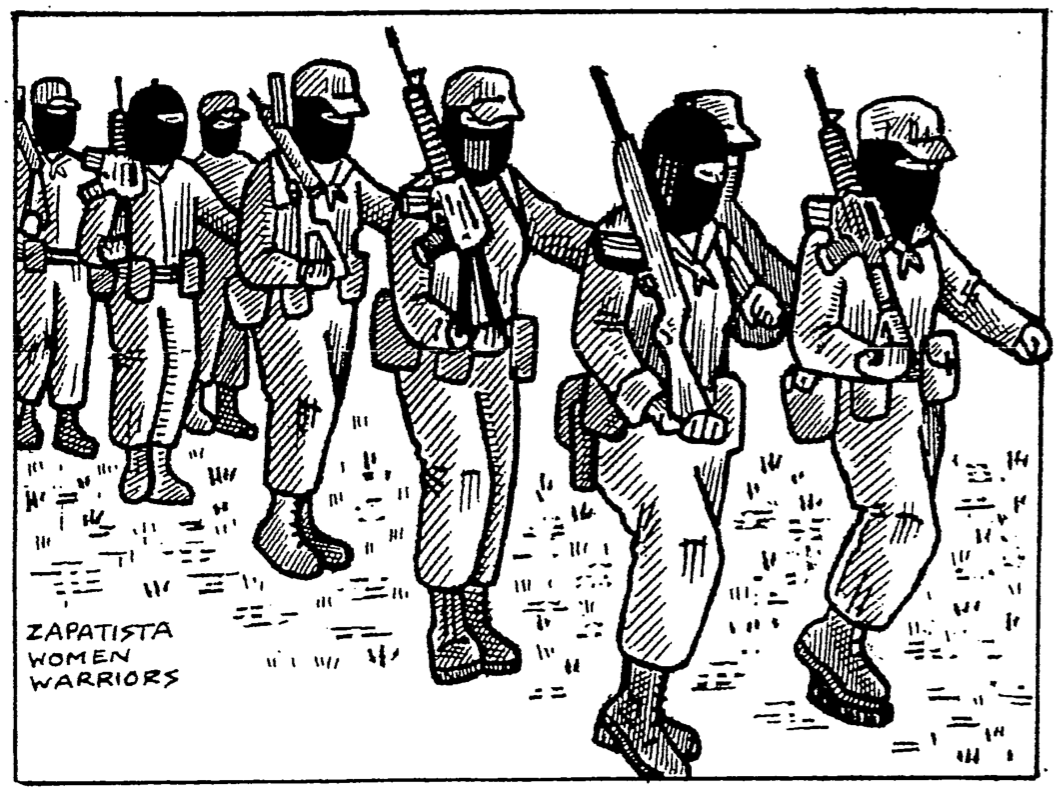
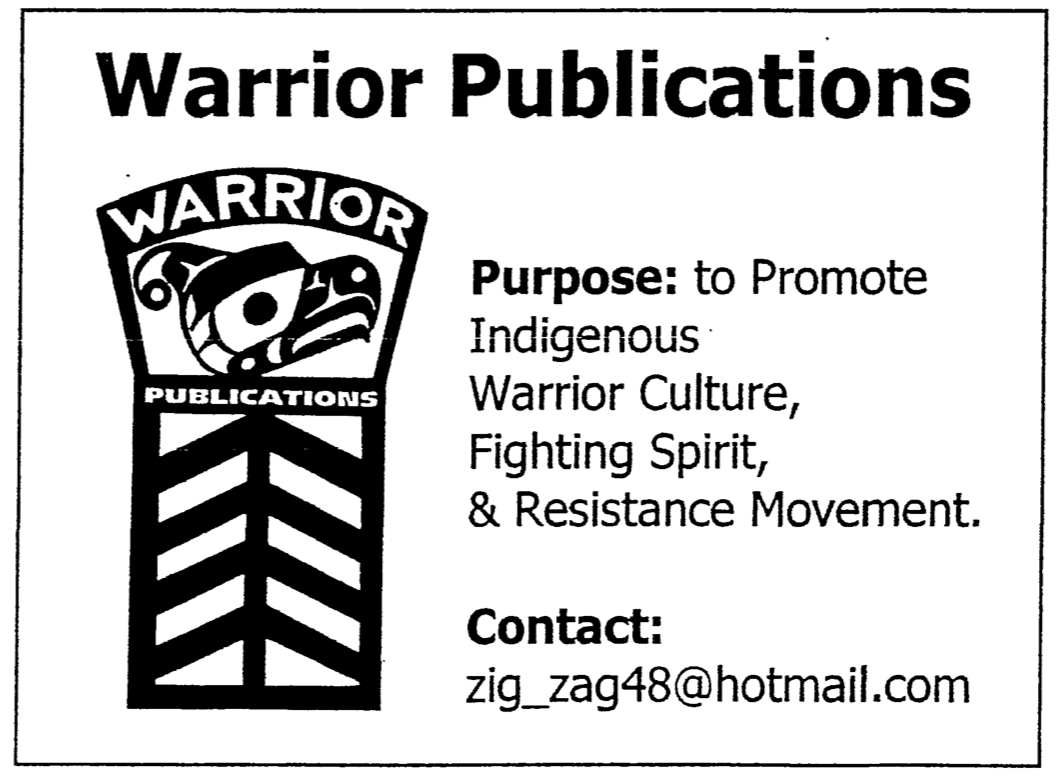
Colonization & Decolonization
by Zig-Zag Spring 2006
"Liberation is the task imposed upon us by our conquest and colonization."
-- (Chtnweizu, The West and the Rest of Us, p.33)
Introduction
Colonialism: the practise of invading other lands & territories, for the purpose of settlement and/or resource exploitation.
When an invading force confronts an Indigenous population already occupying a territory, colonialism becomes a violent conflict between two hostile and opposing ways of life, with one attempting to impose its will on the other.
This is a standard definition of war, and colonization itself can be considered a war for territory involving all the means used to carry out wars: military, political, economic, psychological, diplomatic, cultural, etc.
Cecil Rhodes, a British colonial official for which Rhodesia (now Zimbabwe) was named, articulated the motives and goals of European colonialism in the 19th century:
"We must find new lands from which we can easily obtain raw materials and at the same time exploit the cheap slave labour that is available from the natives of the colonies. The colonies would also provide a dumping ground for the surplus goods produced in our factories."
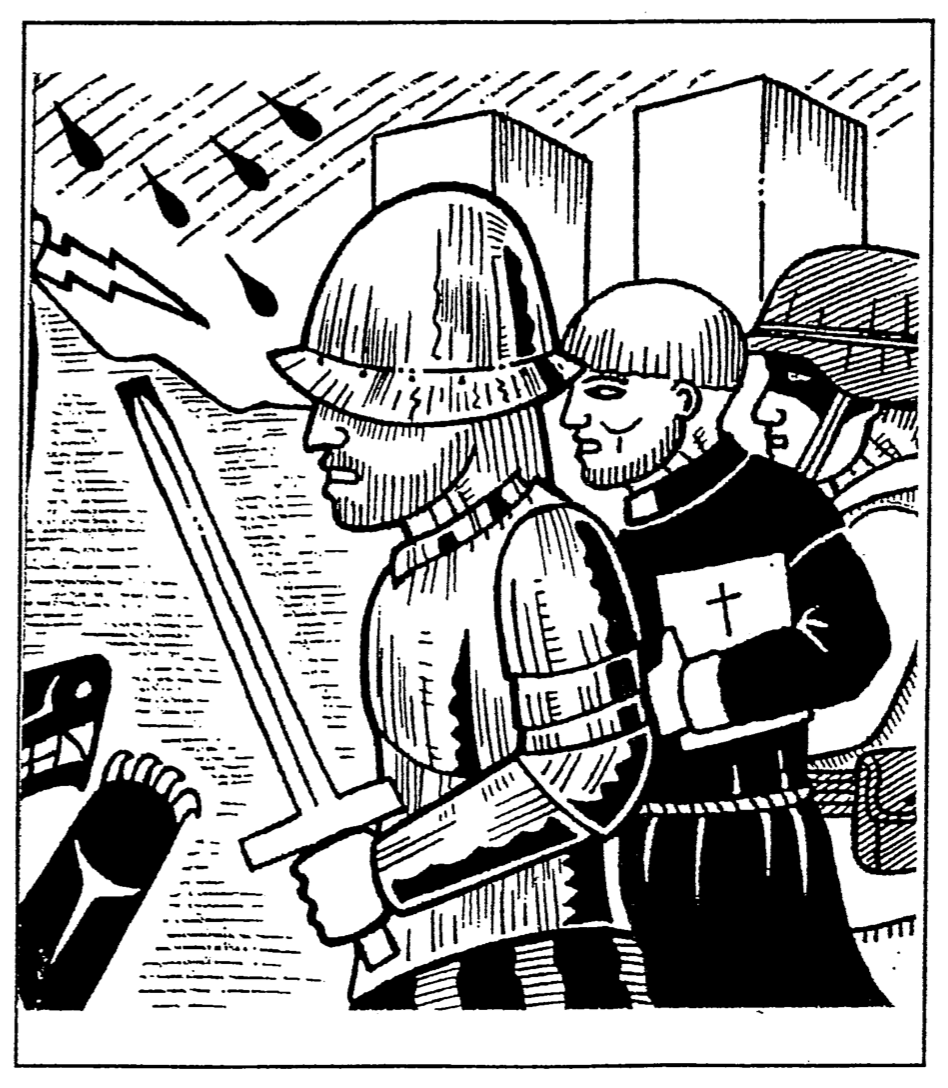
Due to its history and culture, European colonialism is characterized by genocidal practices, including wars of extermination, massacres of non-combatants, biological warfare, and scorched earth policies (destroying food & shelter). Other atrocities include the torture of prisoners, rape, and enslavement of Indigenous populations. These acts are fueled by racist & patriarchal ideology (i.e., Christianity & white supremacy), greed, and a psychopathic desire to kill and inflict violence and suffering on others.
Psychopath n. A person with an antisocial personality disorder, manifested in aggressive,
perverted, criminal, or amoral behavior without empathy or remorse.
-- (The American Heritage Dictionary, p, 1415)
Stages of Colonialism
The methods & history of colonization are unique in every case, due to many different variables (geography, population density, resources, etc.),
Despite this, there are common patterns that can be easily recognized.
In the Americas, Africa, and Asia, colonization generally consisted of 4 stages: recon, invasion, occupation, and assimilation.
1. Recon
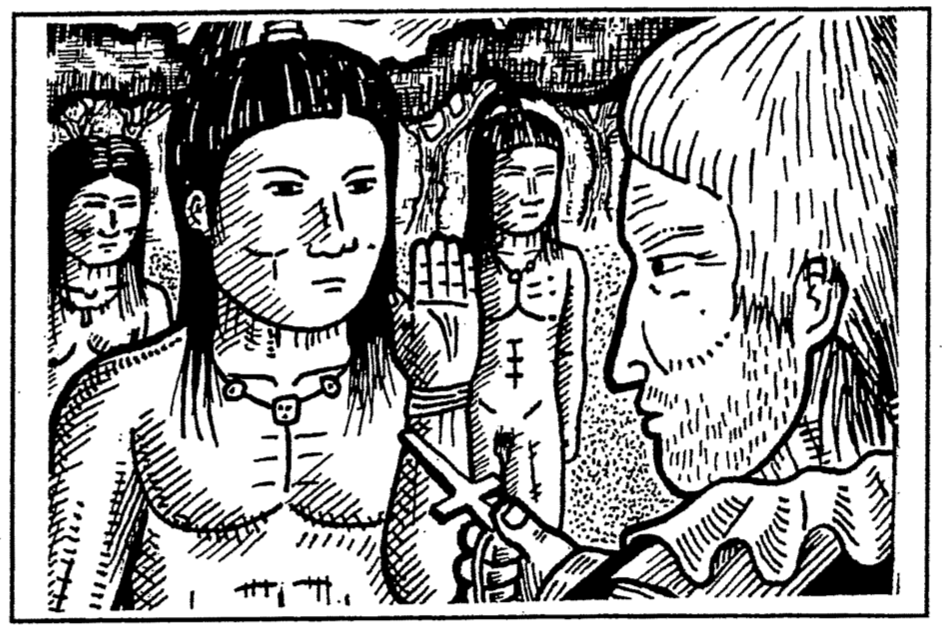
Colonialism begins first with small recon forces that map out new lands or regions and gather intelligence. These are often celebrated today as voyages of "exploration" & "scientific discovery."
The 1492 voyage of Columbus, for example, was a recon expedition to find a new route to Asian markets. There were only 3 ships: the Pinta, Nina, and the Santa Maria.
2. Invasion
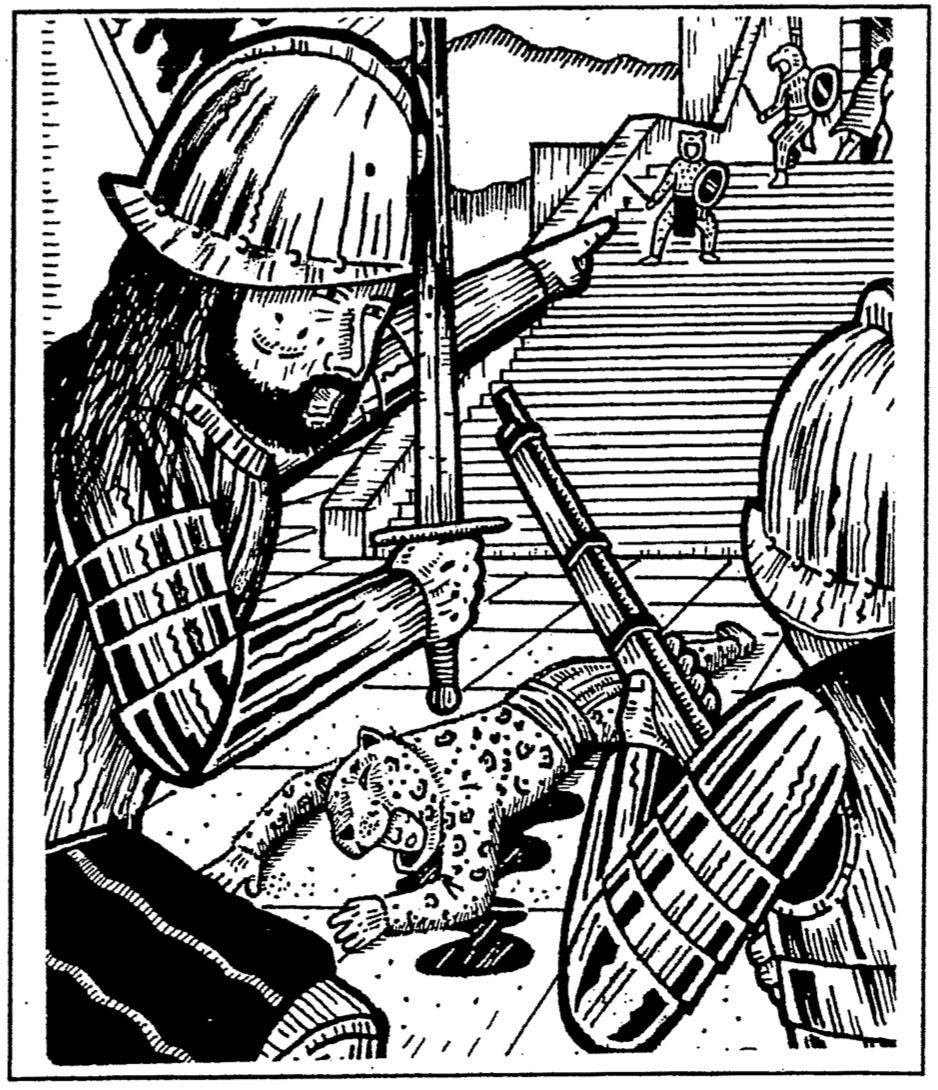
The second phase is invasion, which begins a period of armed conflict as Indigenous nations resist colonial forces. For example, when Columbus returned to the Caribbean in 1494, he had 17 ships and over 1,000 conquistadors. Invasion can begin immediately after the recon, or may be delayed by a period of trade & settlement that serve as a basis for later invasion (i.e., North America). In every case, colonial military strategy is genocidal and includes the destruction of food supplies, resources, & shelter, as well as massacres & biological warfare (disease).
3. Occupation
When Indigenous peoples are militarily defeated, the occupation is expanded. A colonial government is set up to control the surviving population of Natives, who are contained in reservations, or enslaved. By the 1700s, many colonial authorities were corporations (i.e., the Hudson's Bay Company, French Senegal Company, etc.). They organized settlement & resource extraction, including the construction of railroads, dams, roads, ports,
etc.
4. Assimilation
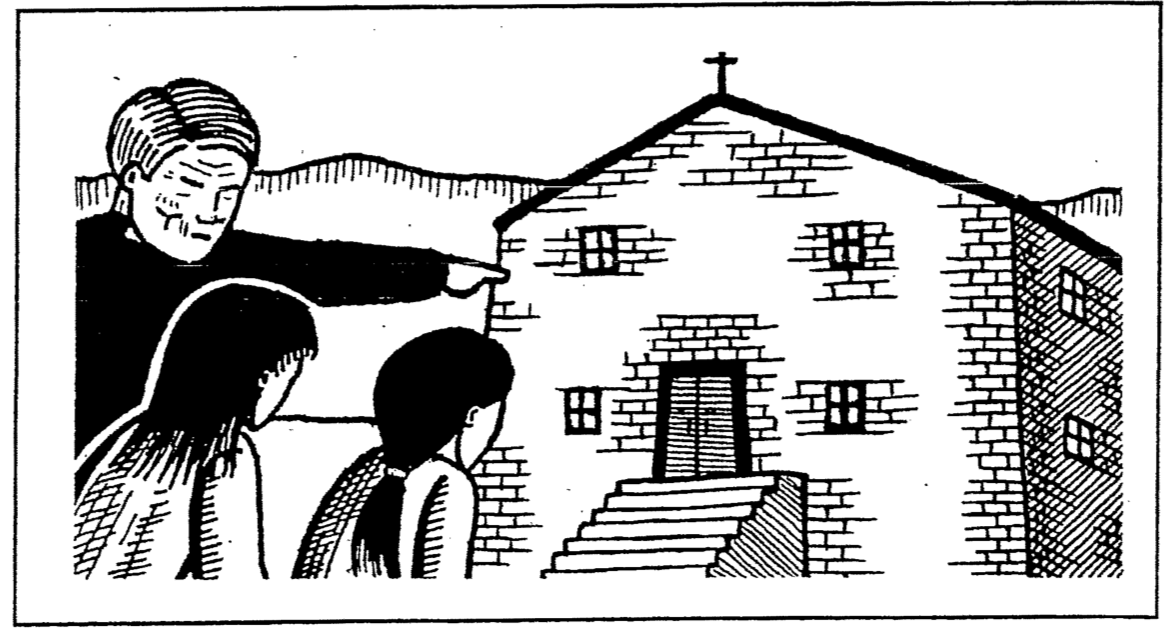
An important part of imposing control is the indoctrination of surviving Natives into the European system. In order to do this, Indigenous
society & culture must be dismantled & erased as far as possible. Colonial violence, including physical destruction and biological warfare, achieve this through depopulation, often during the period of invasion. Once occupation is entrenched, this process becomes institutionalized, with generations of Indigenous youth being removed from their people & forced into government or Church-run schools.
The period of occupation and assimilation are connected, as only through occupation can systems of assimilation be imposed. This phase can be long and drawn out over centuries, as has occurred in the Americas.
1. History of Colonialism
Colonialism is neither new nor limited to any specific historical period (ie., the 'colonial period' of the 15th to 19th centuries). Ancient civilizations were the first to begin colonizing other lands & people. When their populations
became too large, and as resources became depleted, colonists were sent out to occupy and settle new lands. When these lands were already occupied, military campaigns were carried out to gain control.
When nations & territories were conquered, the survivors were enslaved and forced to provide resources, including human labour, food, metals, wood, spices, etc. The invaders then imposed their own forms of governance, laws, religion, and education. Over time, these populations became assimilated into the culture & society of their oppressors.
Early Egyptian Colonialism
In ancient Egypt (around 1,500 BC, or 3,500 years ago), all the methods of colonialism were already being practiced. An African scholar, Cheikh Anta Diop, described these methods:
"In some towns, as in Jaffa, the conquered
princes were purely & simply replaced by Egyptian generals ... Egyptian garrisons were stationed at strategic points, important towns and ports.. 1,400 years before Rome, Egypt created
the first centralized empire in the world.
"The children of vassal [conquered] princes
were taken as 'hostages' & educated in Egyptian style, at the court of the Egyptian emperor, in
order to teach them Egyptian manners and tastes and to assimilate them to Pharoanic culture and
civilization
...
"The Pharoah [emperor] could at any moment
require money, chariots, horses, compulsory war service; the vassal was constantly under the orders of the Egyptian generals... The vassals enjoyed only internal autonomy; in fact they had lost their international sovereignty; they could not directly deal with foreign lands"
(Cheikh Anta Diop, Civilization or Barbarism,
p. 85-86).
European Colonization
When looking at the world today, 'we can see that this process still continues, sometimes referred to as imperialism, globalization, or even 'peacekeeping' and 'humanitarian' missions. Whatever term is used, the principles of invasion, occupation and exploitation remain the same.
Today, the European states & their settler nations dominate the global system. How did this come to be? Why is it that Western Civilization is now the primary economic, political and military power in the world? The answer to these questions can be found in the history of civilization.
Early civilizations concentrated vast amounts of human and material resources under the control of a central authority. This authority was usually in the form of kings and priests, who based their right to rule on spiritual or religious tradition. They controlled all governance, economic trade, law & order, education, etc. Through religion, mind control was imposed over citizens, which created a culture of obedience, slavery, and war (just as we see today).
The first civilizations were established in northern Africa and Mesopotamia (the Middle-East), comprised of the Egyptians, Sumerians, and Babylonians. Other civilizations also began in India, Asia, and the Americas, but those in Egypt and the Mid-East had a direct influence on Europe.
The Greeks were the main transmitters of civilized culture into Europe, based on both Egyptian and Mid-East models. The Greeks, southernmost in all of Europe, were strategically located to serve just such a role. Prior to this, southern Europe was inhabited by tribal peoples. While Egyptians built massive pyramids and cities, had a written language, advanced science and astronomy, etc., Europeans were still hunting & gathering.
This history tells us that colonization results from a society's culture, not its racial or biological background. This culture, based on expansion, control, and exploitation, arises from civilization. Despite this, it is the European system that now dominates the world; the result of history, geography, and the exchange of culture & technology that occurred throughout the Mediterranean.
Roman Colonization

The first people colonized by Western Civilization were the European tribal peoples, such as the Goths (Germany), the Gauls (France & Spain), etc. They were invaded & occupied by the Roman Empire, beginning around 200 BC (some 2,300 years ago):
"Conquered' territories were divided into provinces ruled by governors appointed in Rome for one-year terms. Governors ruled by army-enforced decree... Conquered peoples all had to pay extraordinary taxes to Rome."
-- (Jack C. Estrin, World History Made Simple, p. 65)
Early accounts by Romans described these peoples as worshiping Mother Earth, organized in clans and tribes, living as semi-nomadic hunters and gatherers. They were also strong and adept military forces that inflicted numerous defeats against Roman forces, with some regions never being pacified or conquered (i.e., the Scottish Picts).
Despite this resistance, some areas such as present-day Spain, Portugal, and France, as well as parts of Germany and Britain, were occupied by Roman forces for as long as 400 years. Forced to work as slaves, to build houses and fortifications, to serve as expendable frontline soldiers, to provide resources and manufactured goods, or as servants (cooks, janitors, barbers, tutors), these conquered peoples were also increasingly assimilated into Imperial Rome.
Tribal chiefs and high-ranking families were targeted for systematic assimilation; often, their children were taken and taught how to speak and read Latin (the language of Rome). Roman clothing and overall culture were imposed. After several generations, these peoples were effectively Romanized or Latinized, with some gaining citizenship and high ranking positions in the Roman military or political system. These families, along with the Roman governing system and the Christian church, served as the basis for the feudal system which evolved in Western Europe after the collapse of the Roman empire (5th century BC).
Perhaps more than any other region, Europe stands as a stark-example of the effects of colonization & assimilation. Today, very little remains of the European tribal cultures, which were destroyed & assimilated into the Roman imperial system (which explains why European civilization is essentially fascist in nature).
1492: Invasion of the Americas
In 1492, the European colonization of the Americas began with the voyage of Christopher Columbus, in command of the Nina, Pinta and the Santa Maria. This recon expedition arrived in the Caribbean and landed on the island of present- day Haiti and the Dominican Republic, which was named Hispaniola.
In 1494, Columbus returned with a second, larger force, comprised of 17 ships and 1,200 soldiers, sailors, and colonists, By 1496, it is estimated that half of the 8 million Indigenous peoples on Hispaniola were dead, killed by a combination of European diseases & massacres. Both priests & conquistadors have left detailed accounts of their atrocities, killing for fun, hunting Indigenous peoples as if they were animals, and devising all kinds of cruel and inhuman methods of torture. Survivors were enslaved and forced to supply gold, silver and food to the conquistadors. Those who failed to meet their quotas had their hands, ears or nose cut off. From this strategic location, military campaigns were conducted into nearby islands; by 1510, the Spanish were relocating Indigenous peoples from the Bahamas and Cuba to replace the dying slaves on Hispaniola.
By 1535, Spanish conquistadors had launched military operations into Mexico, Central America, and Peru. Using guns, armour, and metal edged weapons, as well as horses, siege catapults, war dogs, and biological warfare, the Spanish left a trail of destruction, massacres, torture and rape. Tens of millions of Indigenous people were killed within the first century. The Mexica (or Aztec) alone were reduced from some 25 million people to just 3 million. Everywhere the death rate was between 90-95 % of the population.
The European invasion of the Americas was, without question, the most devastating genocide and holocaust in history. Despite this, it is still celebrated today as a 'discovery'. With some exceptions, the history of this holocaust has been minimized or concealed.
The main goal of the Spanish and Portuguese was to take control of the land and enslave the surviving Indigenous people. Settlement was not a main objective. They established huge plantations to grow crops for export to Europe, while vast ranches were set up for cattle raising. Mines were opened to dig for gold and silver. Millions of Indigenous people were enslaved and died working in these mines.
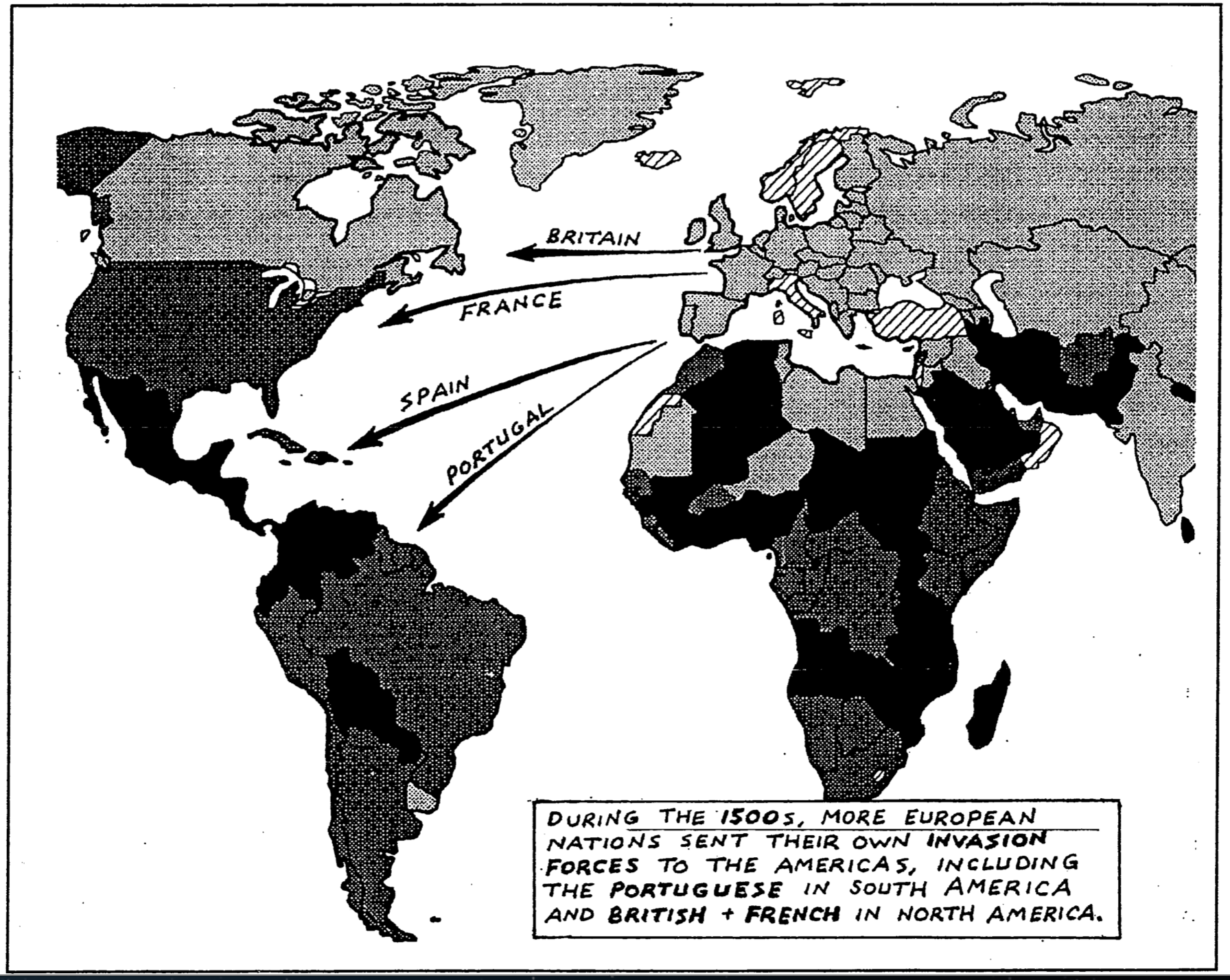
In order to maintain a source of slaves, European traders turned to West Africa. There, Indigenous Africans, engaged in intertribal war, traded prisoners of war with the Europeans, clearly ignorant or indifferent to the long term effects such actions would have. As many as 15-20 million Africans were shipped on board slave ships, with an estimated 40 million dying from disease & starvation on the trans- Atlantic crossing. Despite this high level of violence & destruction, Spanish & Portuguese colonial forces were largely restricted to the coastlines of Central & South America. Many interior regions resisted for 2-3 centuries and were never conquered by the
Spaniards. The Maya in the Yucatan Peninsula, for
example, withdrew into the forest lowlands, where Spanish forces fell victim to disease and the intense heat. The Maya then launched military attacks and were able to resist total Spanish control.
By 1800, the Spanish laid claim to a vast region encompassing parts of South, Central, and North America. Despite this, it was an empire in decline, faced with ongoing Indigenous resistance, slave rebellions, and even settler revolts. By the mid-1800s, settler independence movements forced the Spanish out of the Americas (with the exception of Cuba & Puerto Rico).
At the time of the invasion of the Americas, Europe was in the Dark Ages, suffering from resource depletion, overpopulation, widespread poverty & social decline. Colonialism brought new resources & wealth into Europe, while destroying Indigenous nations in both the Americas and Africa. It is from the colonization of the Americas that the European nations were able to further expand and dominate the world.
1498: Invasion of North America
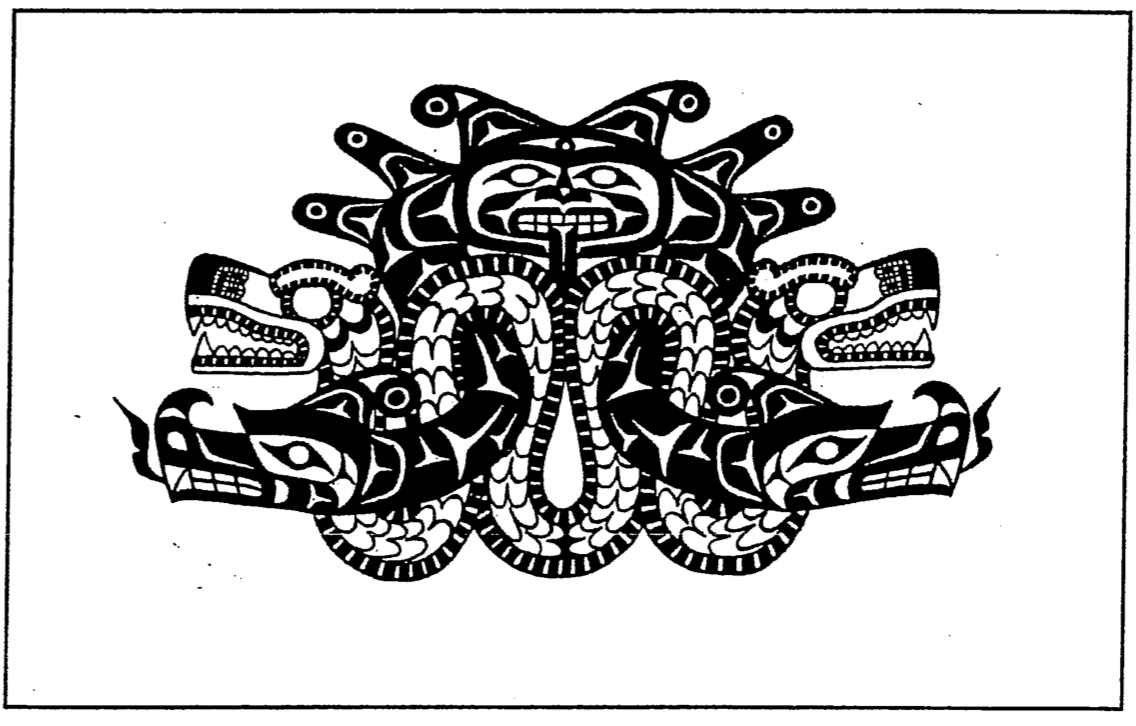
In 1498, John Cabot, sailing under command of the English King, claimed the east coast of present-day Newfoundland. He was followed by the French shortly after. Throughout the 1500s, the British & French attempted several colonies on the east coast of the US, but none survived the harsh winters (or, in the south, attacks by the Spanish). Finally, in 1607, a British colony was established at Jamestown, Virginia. It survived due to the help of Indigenous peoples (the tradition of Thanksgiving, adapted from Indigenous peoples, arises from this).
These early British settlers took great care to not engage in any offensive actions, especially as Indigenous peoples were militarily stronger. At first, peace & friendship treaties were made. As colonist's numbers grew, they began to seek greater land and resources, especially the agricultural lands of Indigenous peoples. By the 1620s there was all-out war in the north-east, with colonists carrying out massacres and scorched earth policies. Combined with the effects of biological warfare (smallpox), these attacks gradually broke the ability of Indigenous nations to militarily resist.
Unlike the Spanish & Portuguese in the south, the British & French found little gold or silver with which to finance large-scale invasion. Instead, they relied on trade with Indigenous nations (i.e., the fur trade)- as well as the gradual development of agriculture for export to Europe. For this reason, a dual policy of maintaining friendly relations with some, while waging war on others to gain territory, was used. Over time, however, even those that actively collaborated with the settlers were attacked, their lands taken, and their populations enslaved..
A main focus for the French & British was the transfer of large numbers of citizens to the colonies in order to relieve the pressure of over-population, as well as to garrison them against other European powers. Settlement was therefore a major factor in the colonization of N. America.
As in South & Central America, Indigenous populations suffered death rates of 90-95 % across North America. Although diseases had a major impact, they were most often accompanied by wars of extermination that targeted not only men, but also women & children. Those not killed by disease or massacre suffered starvation, as villages and crops were systematically burned by heavily armed European militias. Extermination of Indigenous people was an official policy of colonialism, limited only by the potential to make money through slavery.
Competition between the French & British led to a series of wars, fought both in Europe and in the American colonies. By 1763, France was defeated and surrendered its colonies to the British (including present-day Quebec). In turn, the British reorganized their colonial system and imposed new taxation on the colonies themselves, to help pay for the costs of war.
Along with this, the British issued the 1763 Royal Proclamation. This law limited the expansion of colonies by imposing a western boundary line (along the Appalachian Mountains). Only British Crown forces could trade, acquire land, and conduct other business in the .'Indian Territories'. This act, which also recognized Indigenous sovereignty to land, served to limit some Indigenous resistance. At the time, the British were faced with an insurgency led by Pontiac, with an alliance of Ottawas, Algonquins, Wyandots, and others. They had captured 9 of 12 British forts and laid siege to Detroit for 6 months.
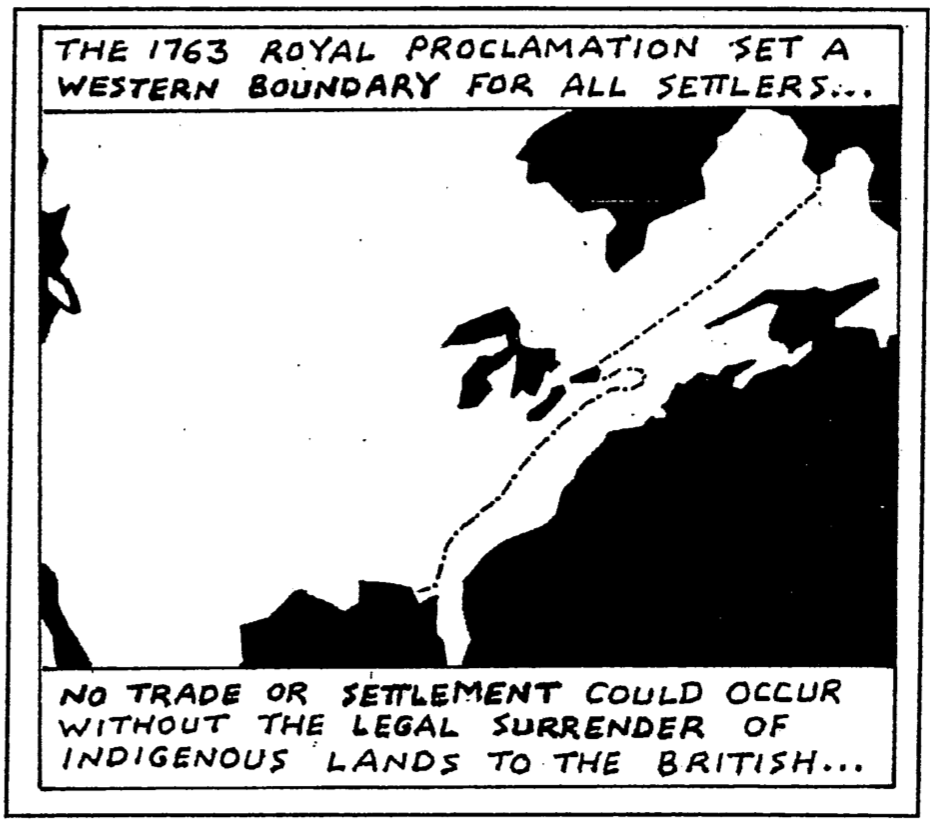
New taxes & the 1763 Royal Proclamation angered many settlers in the 13 original colonies, especially their exclusion from gaining more land. Real estate had become a huge business, with settlers taking land by violent conquest and selling it or growing cash crops such as tobacco. In response, they organized an armed revolt against the British in order to establish an independent Euro-American empire.
Settler Revolts in the Americas
The Euro-American Revolution of 1775-83 was the first in a series of settler independence revolts in the Americas. Unrestrained by British colonial policy, the new USA began a rapid military expansion westward, killing, enslaving, or relocating Indigenous peoples. At the same time, tens of thousands of European immigrants were brought in. Despite this, it would take over 100 years for Indigenous resistance to be defeated by US forces.
In the early 1800s, inspired by the 'American Revolution', settler revolutions occurred throughout South & Central America, with new independent nation-states being created (ie., Bolivia, Chile, Peru, etc.). Although these movements kicked out European colonial powers, they did not liberate the Indigenous peoples. Instead, it was the immigrant European elites & their descendants who assumed power. We do not refer to these as examples of anti-colonial resistance.
By the late 1800s, these settler governments began to take out huge loans from European banks. These loans were used to build roads, railways, dams, ports, etc., in order to better exploit the natural resources. US & European corporations became heavily involved in these countries, where they could make huge profits exploiting cheap labour, land and resources. This period established the imperial relationship between the 'Third World' & the Western powers, based on debt and repayment of loans.
Afrikan Slave Revolts
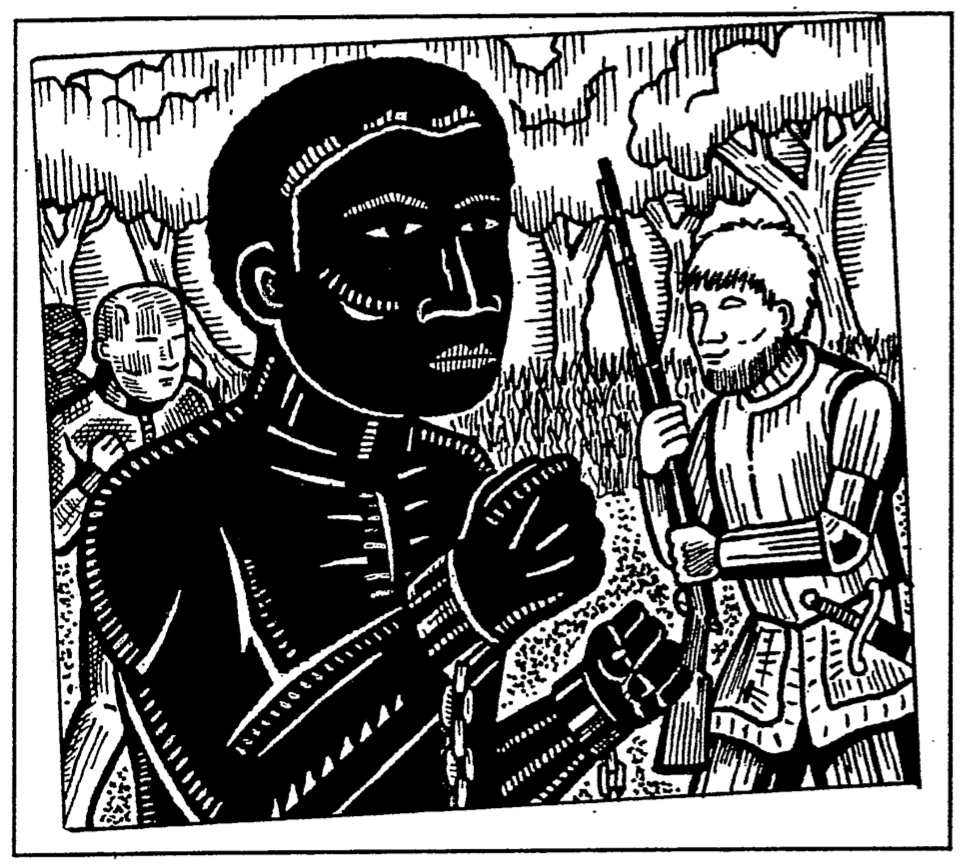
As early as 1526, Afrikan slaves had rebelled against their European 'masters'. In some regions, such as Brazil, escaped Afrikans established liberated zones, defending them against colonial forces. In the Caribbean, Central and South America, escaped Afrikans also found sanctuary among Indigenous peoples.
During the 'American Revolution' in the US, the British offered freedom to Afrikan slaves. As many as 100,000 are believed to have abandoned the slave-plantations and to have fought with the British. Many Afrikan units continued fighting after the British defeat, others went to Canada, and those that didn't were re-enslaved.
While the Euro-American settler elite were planning and executing their continental expansion, Afrikan slaves in Haiti rebelled and defeated French forces in 1791. This had an alarming effect on the US, where some began to realize the dangers of having a large Afrikan slave population. In 1800, a large slave revolt occurred in Virginia. Efforts were made to reduce the numbers of slaves; in 1808, the government banned the import of new slaves.
In 1812, settler vigilantes attacked Seminole communities in Florida in an attempt to re-capture escaped Afrikan slaves, who had gained sanctuary among the Seminole. This began the first phase of the Seminole Wars, which cost over 1,600 dead US soldiers and millions in dollars. Even after the Second Seminole War of 1835, the Seminole and their Afrikan allies remained undefeated.
Meanwhile, slave revolts continued. By the 1820s, many cities had large numbers of Afrikans, often concentrated in certain areas. Although most were slaves, and urban slaves outnumbered those on plantations, an increasing number were also escaped slaves. They were able to find sanctuary in large numbers. As a result, many insurrections and rebellions had their origins in urbanized slaves. By the 1830s, large numbers of these slaves were being re-located to the plantations. It was also felt that too many Afrikan slaves were being exposed to education and learning "too much" in the cities.
By the 1850s; slavery had become a dividing policy among the southern and northern settler elites. The slavery-based plantation system of the south was now seen as retarding the interests of empire, threatening it with Afrikan revolution while limiting the growth of the northern industrial-capitalist system. What the US needed was a vast army of Euro-settlers to take and hold territory, to work in the factories & farms, to produce & consume.
Between 1830-60, some 5 million European settlers emigrated to the US. By this time, the struggle for power between the north and south erupted into the US Civil War (1861-65). Again, freedom to New Afrikan slaves was promised, this time by the northern forces. Once again, tens of thousands escaped and joined the northern Union army. With this mass withdrawal of slave labour, further strengthening the north, and unable to compete against the economic and industrial capacity of the north to wage war, the south was defeated.
New Afrikans in the south immediately organized to defend their freedom. Strikes and armed occupations of land occurred. The new northern government offered limited political, legal, and property rights, while attacking the most militant elements. Union soldiers also disarmed Afrikan army units, or redeployed them to the ongoing 'Indian Wars' on the plains.
But these reforms were too much for southern settlers, thousands of whom joined white supremacist groups such as the Ku Klux Klan to wage a campaign of terror against blacks. Thousands of Afrikans were killed during state elections. The north withdrew its forces and allowed local settler regimes to regain power, who maintained a brutal system of apartheid until the civil rights struggles.
Final Phase of N. American Indigenous Resistance: 1800s
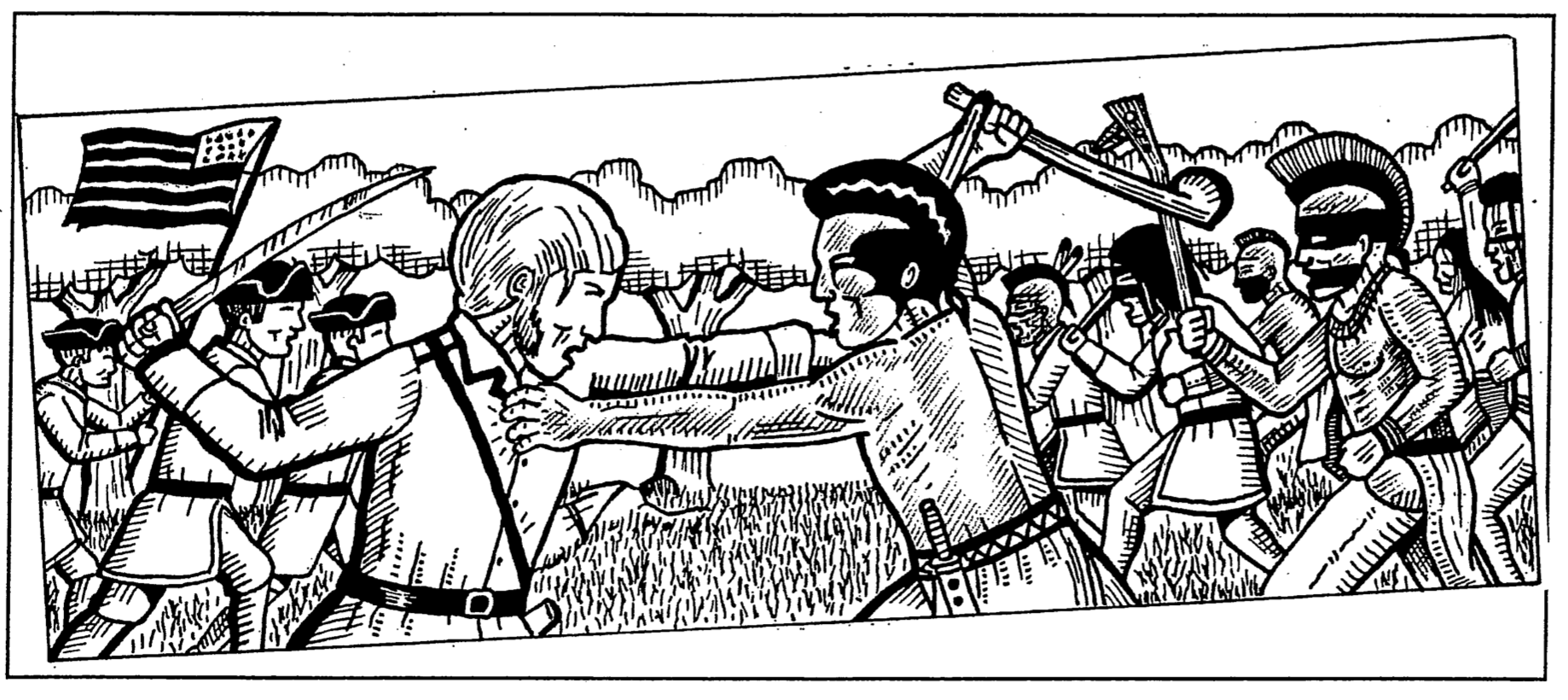
In 1812, US forces attempted to invade eastern Canada. At this time, Britain was again at war with France, and the US hoped to take advantage of this. They were repelled, however, by a small British force and an alliance of Indigenous warriors. It is generally acknowledged that, had it not been for the involvement of Indigenous peoples, the US would have been successful. This resistance was led by Tecumseh and Blackhawk, who also helped organize insurgencies against European colonial forces throughout this period.
In 1838, US troops forced thousands of Cherokee into prison camps and then, in winter, on the Trail of Tears, a forced relocation during which one in four died. Numerous other nations were also forcibly relocated, including the Choctaws, Creeks, Shawnees, Miamis, Ottawas, Delawares, and others, Many were sent to Oklahoma.
In 1848, the US invaded and took control of northern Mexico, including California, Nevada, New Mexico, Arizona, Texas, Colorado and Utah. That same year, gold was discovered in California, setting off an invasion of settlers that decimated Indigenous nations in that region.
In the 1860s, as the US Civil War raged, Indigenous nations on the plains and in the southwest continued to resist their colonization. Apache resistance, led by Cochise and Colorado, began at this time and would not end until the final capture of Geronimo, in 1886.
In 1863, the Shoshone began attacks against invading settlers and military forces in Utah and Idaho. As well, the Diné in New Mexico and Arizona began to carry out attacks against colonists. During this time, US, British and Russian colonists were also active on the Northwest Coast. In BC, British navy gunboats were used to bomb villages, destroying houses, canoes and food supplies.
On the plains, the Lakota, Cheyenne, and Arapaho began to wage guerrilla war against US troops and settlers. From the 1860s to '70s, the US Cavalry suffered numerous defeats (including the defeat of Custer, 1876) and lost several forts. By 1885, however, the last great buffalo herd was slaughtered by settlers, depriving the plains nations of their single most important source of food, shelter, clothing, etc.
That same year, the Metis and Cree in southern Manitoba rebelled against British Canadian authorities (led by Louis Riel and Poundmaker). The British were able to use the destruction of the buffalo herds to impose control on the plains nations in Canada, forcing them to sign treaties and live on reserves.
At the same time as these military campaigns were being carried out, diseases continued to have a devastating impact on Indigenous populations. At times, the intentional use of biological warfare was also used to destroy Indigenous resistance.
By 1890, Indigenous peoples in both Canada and the US were militarily defeated. That year, nearly 300 unarmed men, women and children were massacred by the US Cavalry at Wounded Knee, South Dakota. At this time, the systematic assimilation of the surviving populations began; with Indigenous peoples relocated to reserves and generations of children forced into residential schools, where they were indoctrinated with European culture & ideology, language, religion, etc. Many suffered physical, mental and sexual abuse, while tens of thousands would die from diseases such as tuberculosis & influenza.
Africa, Asia, and the Middle-East
Although the Portuguese had begun trading and raiding along the African coasts in the mid-1400s, European colonialism on the continent remained limited for several centuries. The first attempts by Portuguese forces to invade were met with strong resistance and deadly African diseases. The main concerns for Europeans were economic trade and securing slaves for the colonization of the Americas. In North Africa, Europeans were limited by the presence of large and equally powerful Islamic civilizations. Despite the crusades of the 10th-12th centuries, Europe was unable to invade and conquer these empires.
Until the mid-1800s, most of the African interior remained unmapped and unknown. It was referred to as the 'Dark Continent', a land of black 'savages' and deadly diseases. At this time, new antibiotics were developed and more European explorers began to penetrate beyond the coastlines into the heart of Africa. Here they encountered nations already depopulated and weakened after centuries of the slave trade. Europeans were also armed with far more deadlier firearms, cannons, etc. As a result, a new phase o f European colonialism began. As in the Americas, millions o f Indigenous Afrikans were killed and enslaved, while European nations looted and plundered the natural resources.
By this time, colonization -in both North America and Africa were at similar stages. In 1876, the Lakota, led by Crazy Horse and others, destroyed Custer and the 7th Cavalry. In 1879, Zulu warriors completely destroyed British forces at the Battle of Isandhlwana. Likewise, by the 1890s, machine guns were used to massacre men, women & children, both in North America and the African Congo.
In the 1920s, as a result of World War 1, the Ottoman Empire was weakened. This empire held together the Arab Islamic civilizations of the Middle-East. During the war, the Ottoman rulers had sided with Germany. Following their defeat, the Mid-East was divided up between the Western powers, especially Britain and France. They took control of countries such as Iraq, Iran, etc., as well as their oil and gas resources.
In Asia, Spanish and Portuguese forces had conducted extensive recon missions during the 1400s, establishing trade with the Chinese and other Asian empires. Here again, in the face of an equally powerful civilization, the Europeans were unable to simply invade and occupy (with the exception of islands such as the Philippines, invaded in 1565 by the Spanish). While Europeans were able to take control of international trade in Asia during the 16th & 17th centuries, it was not until the mid-1800s that many Asian nations came to be controlled by Europeans (primarily the French & British, including India, Burma, Laos, Vietnam, Cambodia, Malaysia, etc.).
World War & The Rise of the USA
By the early 1900s, virtually the entire world was divided up between the (primarily) European & US empires.
The final phase of this occurred in Africa, where the Europeans divided up the continent among themselves. After this, there were no new lands to invade & colonize. Having taken possession of the world's peoples and lands, the imperialists turned against one another (as they had for centuries). World War 1 was the inevitable result of this power struggle for global domination.
While Western Europe was devastated from 1914-18, with as many as 20 million killed, the US remained largely untouched. Although there was widespread repression inside the US, including mass arrests and deportations of tens of thousands of European immigrants labeled 'subversives', the US did not suffer any combat on its own soil. Entering the war only in 1917, the US emerged in a stronger economic and military position than the Europeans.
As a result of the war and forced industrial production (under Martial Law), the US economy expanded. The post-war economic 'boom' of the 'Roaring Twenties' ended in 1929 with the collapse of the stock markets and the beginning of the Great Depression. The party was over. Seen as the result of over-production, this economic crisis forced tens of millions around the world into unemployment, poverty, and starvation.
In response to this crisis, and the threat of communist revolution (i.e., the Russian Revolution of 1917), many Western governments resorted to police repression and, in the case of Italy, Germany and Spain, fascism. Nazi Germany, established in 1933, was funded and supported by many businessmen and politicians in the US. By 1939, Germany had invaded neighboring countries including Austria and Poland. This aggression was used as a pretext for World War 2.
Portrayed as a war to end fascism, World War 2 was in reality a result of the unresolved power struggle that had initiated the First World War. While Western Europe and Asia were devastated by the war, once again the US emerged unscathed and strengthened. At the same time, the Union of Soviet Socialist Republics (USSR) extended its control over Eastern Europe. As a result, the world was divided into two major blocs: the capitalist West and the communist East.
World War 2 and UN 'Decolonization'

As a result of the destruction of World War 2, former European empires were unable to maintain direct control of their colonies as new anti-colonial movements emerged in Africa and Asia. Many of these struggles were the result of power struggles between the US and the USSR during the 'Cold War'. Decolonization was also promoted by the US as a means of further undermining W. European states and extending US imperialism.
The result was an explosion of anti-colonial insurgencies in Africa and Asia, wars of liberation that succeeded in forcing out European powers. Some of the hardest fought battles were those of Algeria, Vietnam, Mozambique, Kenya, and Rhodesia/Zimbabwe. This period of anti-colonial war extended from the 1950s into the mid-70s.
As a part of this, the United Nations was used to assimilate these new independent nation-states into the global system (based on rhetoric of peace & human rights). The UN, it should be noted, was itself set up by the US in the aftermath of WW2 to impose just such a system. The US also provided funding and built the UN headquarters in New York City.
At the same time, the US also established the International Monetary Fund & World Bank, Along with the UN, these groups were used to reconstruct the global system after the war. The main beneficiaries were US corporations. The post-WW2 period is often remembered as a US 'Golden Age' of US prosperity and stability.
Since its establishment, the UN has served as a convenient cover for Western imperialism, giving legal & moral sanction to ongoing colonial invasions (including Korea and Vietnam Wars, the Congo, Iraq in 1991, Somalia, Haiti, Afghanistan, etc.). These are termed 'peacekeeping' or 'humanitarian' missions, although their primary purpose is to maintain or re-impose Western control.
After gaining independence, many colonies remained dependent on the western economic system (a legacy of colonialism, including large-scale export of agriculture, petroleum, & minerals). Decolonization, in fact, served to open up these former colonies for penetration by US-based corporations. Others became dependent on the USSR for industrialization & modernization of military forces. Overall, decolonization did not fundamentally alter the imperialist relationship between the Western nations & Africa and Asia.
Vietnam and US Domestic Rebellion
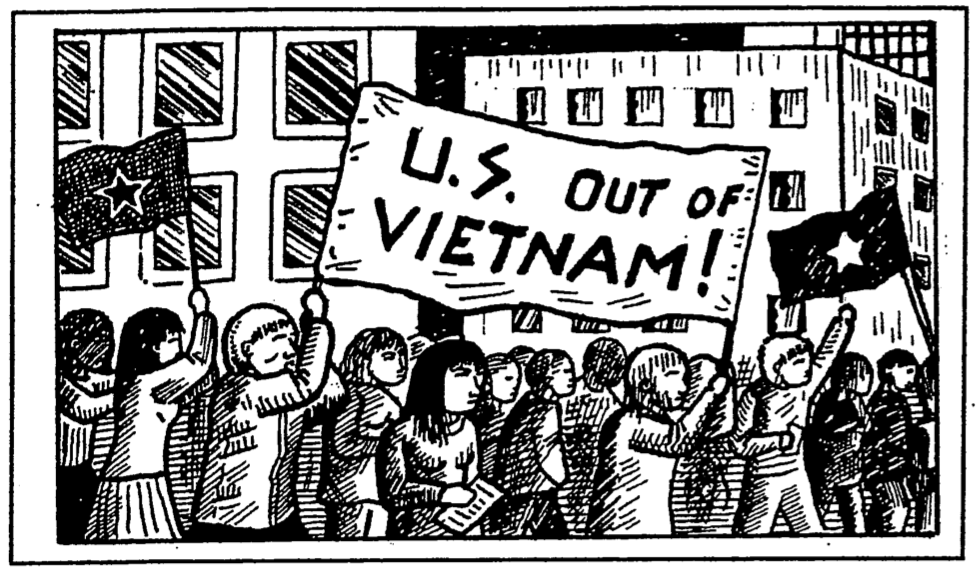
Vietnam was first colonized by the French in the mid-1800s. After World War 2, anti-colonial resistance to the French in Vietnam increased. By 1954, Vietnamese guerrillas had defeated the French during the Battle of Dien Bien Phu. The US, which had begun aiding the French in the early 50s, began increasing its involvement. At the same time, the UN partitioned the country in half. The north was controlled by the Vietnamese communists, while the south remained a puppet regime for the US.
As Vietnamese resistance to foreign occupation continued in the south, more US forces became involved. At first, a handful of Special Forces were sent in to train & organize anti-guerrilla forces. By 1968, over 500,000 US troops were in Vietnam.
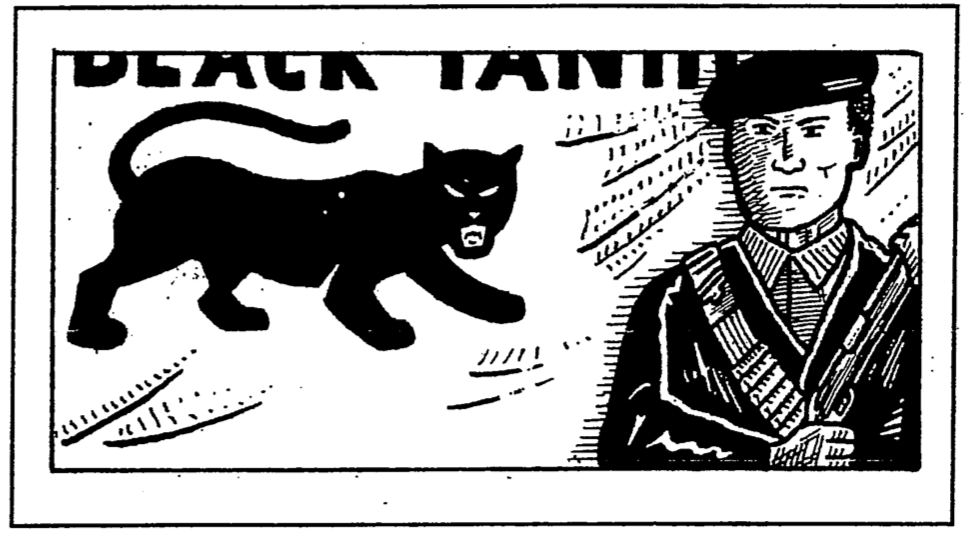
At this time, resistance movements had emerged around the world, inspired by the anti-colonial wars of the time. One of the most influential was that of the Vietnamese, which created a climate of insurgency & rebellion. Inside the US itself movements such as the Black Panthers, Puerto-Ricans, Chicanos, Indigenous, student, women's, gay & lesbian, and others began. These were also part of a broader, multinational anti-war movement.
During the same period, large-scale urban riots occurred, primarily by blacks, during which National Guard troops were deployed to maintain order. Many civilians were killed, and tens of millions of dollars in damage inflicted. In response to these increasing revolts and organized resistance, the FBI intensified its domestic counter-insurgency campaign (the Counter-Intelligence Program (COINTEL-PRO). Many movement organizers were killed, imprisoned, assaulted, etc.
Meanwhile, US forces in Vietnam became increasingly demoralized. Many citizens & soldiers alike began to question the purpose of the war. Insubordination and drug use became common among US combat forces, with entire units refusing to fight, or avoiding combat. Commanders became the target of 'fraggings' (a term that arose from the practice of using grenades to kill or wound commanders seen as dangerous or reckless).
Many combat veterans returned from the war, traumatized, but also angered and disillusioned with their country. Some became involved in resistance movements and added their combat skills & experience to these. By the early '70s, in the face of lethal repression, urban guerrilla groups had formed in the US, including the Black Liberation Movement, Puerto Rican independistas, and white anti-imperialists. These and many other groups carried out bombings, arsons and armed attacks against police, throughout the country. In 1973, the 71-day siege at Wounded Knee, South Dakota, occurred.
Faced with growing internal revolts, and mounting casualties (as many as 50,000 dead), from an increasingly unpopular war, the US had retreated from Vietnam by 1974. This domestic unrest, and the refusal by large segments of the population to support wars of this nature, has been termed the 'Vietnam Syndrome'.
The New World Order
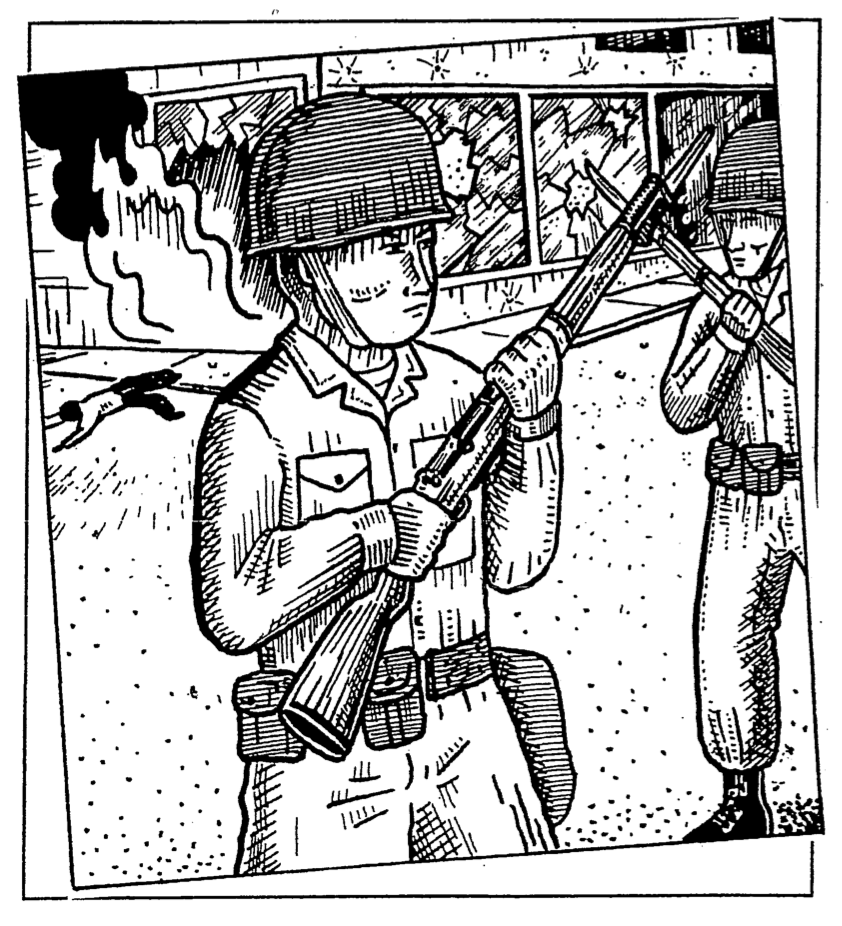
The term 'New World Order' was first used by US President George Bush Sr. in 1990 as the US prepared to invade Iraq. This 'new order' was the result of the collapse of the USSR and, with it, the entire communist East Bloc. With the demise of the USSR, the US emerged as the dominant global power, the strongest economic & military force in the world.
With the threat of Soviet reprisal now removed, the US invaded Iraq in 1991, severely damaging Iraq's military and infrastructure. As many as 200,000 civilians are estimated to have been killed. A UN embargo was then placed on Iraq, limiting imports of food, medical supplies, and equipment necessary to rebuild. The UN also set quotas for Iraqi oil production, continuing the export of oil in exchange for food imports. US/UN forces also established bases around Iraq and carried out systematic bombing campaigns, including cruise missile strikes.
War for Oil & Domination
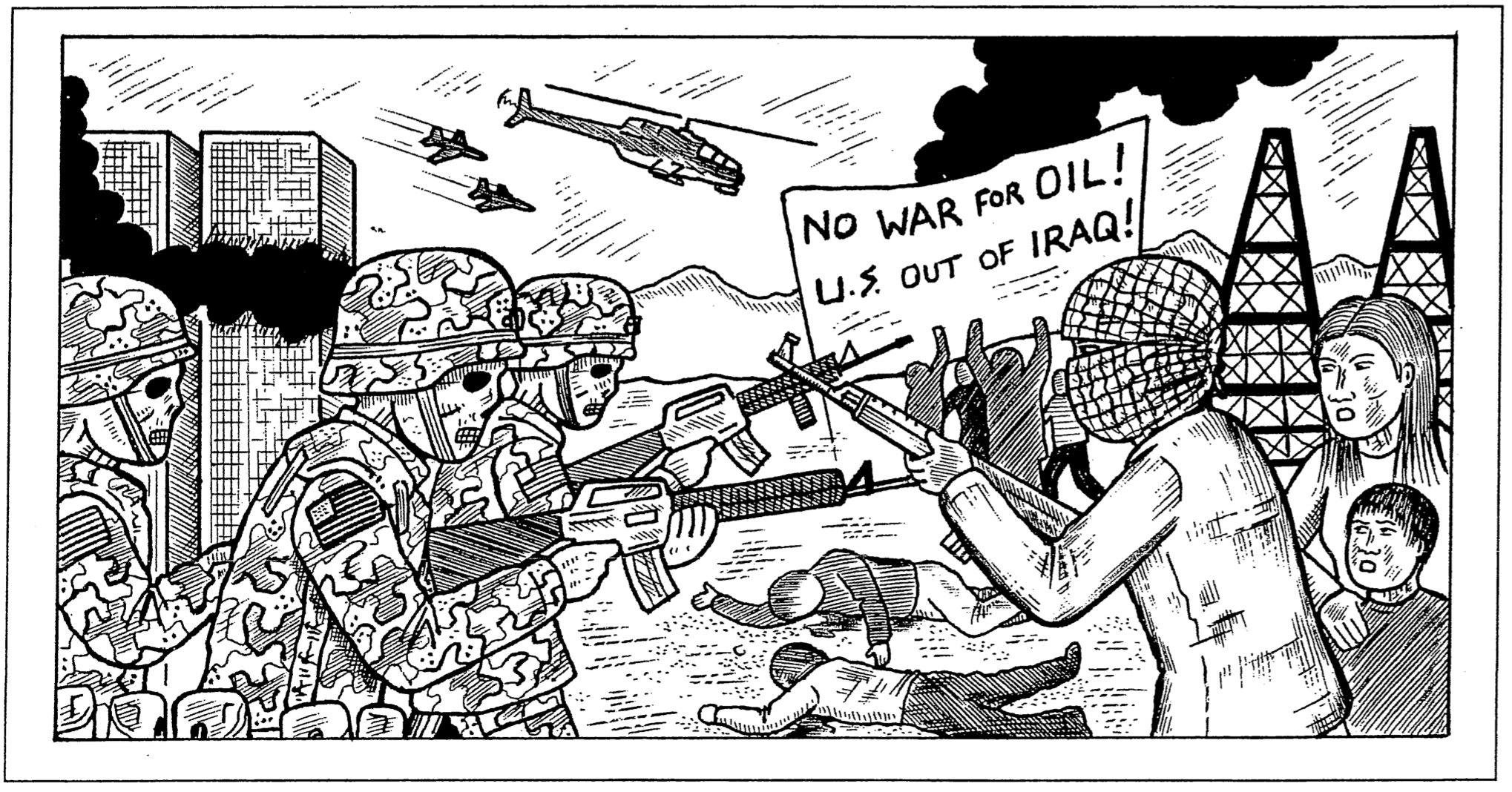
The US/UN siege of Iraq continued until 2003, when the US again invaded. The invasion of Iraq is part of a larger US strategy to take direct control of Mid-East oil, part of its plans for global domination. One official described it as a "stupendous source of strategic power and one of the greatest prizes in world history."
US involvement in the Mid-East increased after World War 2, following the retreat of primarily British and French forces during the period of 'decolonization'. Corporations such as Exxon, Gulf Oil, Standard, and Texaco moved in. Israel (established in 1948 through Zionist war & terror) is a vital part of overall US control, serving as a US fortress and a source of instability in the region. Other Arab countries, such as Saudi Arabia, Jordan, and Egypt, are the largest recipients of US military & economic aid in the world.
Planning and preparation for direct US invasion of the Mid-East began in 1973, during the 'Oil Crisis' when Mid-East Arab nations cut oil supplies in protest of US-Israeli military aggression in the region. Following this, US military forces began extensive training & preparation for desert warfare.
In 1979, an Islamic Revolution in Iran overthrew the US-backed dictator (the Shah) and cut off a valuable source of cheap oil to the US. Demonstrators stormed the US embassy and took over 50 Americans hostage. The hostage ordeal was a humiliating and frustrating event for the US, which appeared impotent and helpless. In 1980, an attempted hostage-rescue ended in disaster when US special forces crashed in the Iranian desert (the hostages were released in 1981).
In 1980, as Saddam Hussein gained power, the US used Iraq to attack Iran: The war lasted until 1988, with two million Iraq & Iranian dead. Western nations, such as the US, Britain and France, supplied arms to both sides, despite widespread atrocities and the use of chemical weapons during the conflict. As the war ended, the US Navy 'accidentally' shot down a civilian Iranian jet, killing nearly 300 passengers.
The Iranian Revolution was a great concern to the US, and it quickly moved to expand its control. In 1980, the US established a Rapid Deployment Force, prepared for short-notice invasion of the Middle-East. From 1980-83, new bases were built in Saudi Arabia & Oman. In 1981, Bright Star annual training exercises began in the Mid-East.
In 1982, nearly 250 US Marines were killed in a truck bombing in Beirut, Lebanon. The marines were part of a UN 'peacekeeping' mission to maintain control of Lebanon. After the withdrawal of Soviet forces from Afghanistan in 1989, the US became an increasing target for Islamic militant groups. It is now common knowledge that these groups had initially been trained, funded, and armed by the CIA during the Soviet war in Afghanistan (including al-Qaeda).
As a result of the September 11, 2001 attacks against the Twin Towers and the Pentagon, the US declared its 'War on Terror', beginning with the military invasion and (ongoing) occupation of Afghanistan. In 2003, the US invaded Iraq, using the pretext of weapons of mass destruction (none were found). Three years later (2006) the US occupation of Afghanistan & Iraq continues (with Iran in between, part of the 'axis of evil' targeted by Bush, including Syria & North Korea).
In Iraq, the US faces an organized and expanding insurgency, while in the US itself a growing number of people are becoming increasingly disillusioned with the war altogether. From its origins in ancient Mesopotamia, the Western imperial system has now gone full circle, invading and destroying Iraq, the homeland of Babylon itself.
Impacts of Colonialism
European Colonial Society
When considering the overall impact of colonialism on Indigenous peoples, one aspect that cannot be neglected is the form of society imposed by Europeans. Although arising from the history of Westem Civilization, colonial society'sare defined by their oppressive relationship with Indigenous populations and therefore have specific characteristics.
Settler-Nations
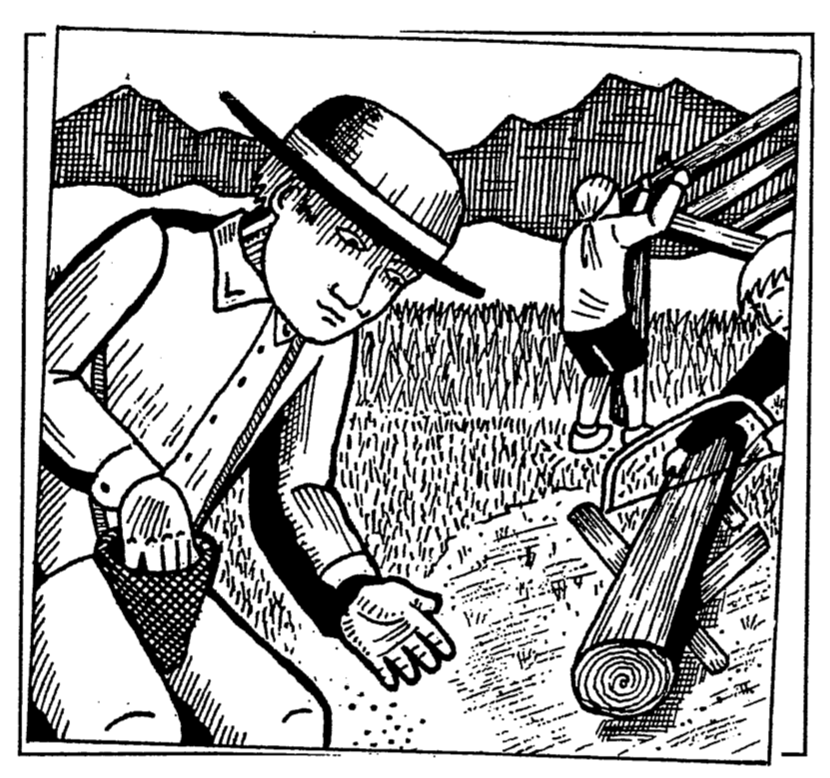
Settler-nations are colonies in which large numbers of European immigrants relocated and eventually set up new nation-states. Canada, the US, New Zealand, & Australia are examples of settler-nations.
Settlerism is, by its very nature, parasitical, taking & exploiting not only land & resources, but also Indigenous culture & knowledge. The lifestyle of most settlers is one of extreme material wealth, luxury, & privilege, characterized by an emphasis on entertainment & recreation,
Although the term settlerism is used, Roman citizens lived a similar life of extreme wealth & luxury. This way of life is essentially imperialist, and this can be seen when considering modern settler-nations in relation to the global system. They are imperialist nations and the lifestyle of most their citizens-especially Europeans-reflects this.
Imperialism
Imperialism is a regional or global system arising from colonialism and based on political, economic and military control. For example, Rome was an empire, and the word imperium (meaning command) is itself Latin in origin. At its height, Rome controlled much of Western Europe, North Africa, and the Middle-East, its influence extending into eastern Asia. Within this vast empire, Rome stood as the capital, with wealth, resources and slaves flowing to it from all around ("all roads lead to Rome"). Rome controlled all trade, governance, and military forces within the empire.
Today, the US dominates a global imperialist system, which also includes Canada and much of Western Europe (the G7: Canada, France, Germany, Italy, Japan, US, and UK). Combined, these countries enforce political, economic and military control over the rest of the world. In this, international organizations such as the United Nations, International Monetary Fund & World Bank play a vital role.
In Africa, Asia, Central & South America, the majority of the world's population are forced to work in factories, mines, oil fields, and farms, extracting resources & producing goods and food, primarily for export to the imperialist nations.
At the same time, these impoverished countries serve as huge markets for Western corporations selling weapons, pesticides, industrial technology & machinery, etc. Control is reinforced through bank loans with strict conditions for repayment. Through this, the World Bank and IMF, for example, can dictate that a national government cut social services, open up certain industries to foreign investment, etc.
Apartheid
Apartheid means 'apartness' and comes from South Africa, once ruled by a white-minority settler regime. Although racial segregation & white supremacy had already been established for several decades, in 1948 it was made an official state policy. Apartheid imposed strict separation of races, including whites, Africans, Coloured (mixed racial groups) & Asians (mainly of East Indian origin). In devising this apartheid system, South African officials sent delegations to Canada & the US to study North American models.
Until apartheid was abolished in 1993, Africans could not vote or own land, their movement was controlled by pass laws, as was their residence & place of employment. Although at first living on reserves, ten large Bantustans were established for Africans based on their tribal nations, beginning in the 1960s. They covered some 14 % of the national territory (Africans being some 75 % of the pop.), Also known as 'homelands', these were declared self-governing & even independent, although no one but South Africa recognized them. In the self-governing Bantustans, Africans lost what limited rights they formerly had as 'South Africans'.
The Bantustans were usually on poor quality land from which neither food nor industry could be created. Many Africans relocated to urban areas where they lived in townships on the outskirts of the city, serving as a desperate & highly exploited work force. The remainder of the country went to the whites & mineral corporations (worked by poor Africans). Apartheid ended as a result of a long resistance campaign by Africans to overthrow the white regime.
In the southern US, the descendants of African slaves were also subjected to an apartheid system until the 1950's, when the civil rights movement arose and dismantled it (some refer to blacks as an internal colony of the US). Although racism has been officially denounced, & apartheid legal systems repealed, blacks in the US continue to suffer from racism as an oppressed peoples.
In both Canada & the US, formal apartheid still exists for Indigenous people. In Canada, this includes the Indian Act and the Department of Indian Affairs, which comprise a set of separate laws, legal status, & political systems for Indigenous peoples. Native peoples continue to live on reserves, usually on land unable to sustain the population through traditional methods. As a result, many resort to some form of resource exploitation in collaboration with corporations.
One result of apartheid is an overall lack of knowledge by non-Indigenous people as to the social conditions under which colonized peoples live. It is, in fact, the establishment of two separate worlds, or social realities (i.e., colonizer & colonized).
White Supremacy
In European settler-nations, racism is more accurately termed white supremacy, the mistaken & arrogant belief that all things good were made by Europeans, who are inherently smarter, better, more beautiful, and stronger than all others. This message is constantly repeated through a variety of means, from official history to media coverage, from entertainment to the justice system. It is so widespread & pervasive that it is accepted as an unspoken truth.
White supremacy is a foundation upon which European civilization is based, a belief that enabled European colonizers to engage in invasion, genocide, and slavery. Christianity was an important method by which white supremacy was maintained. During the invasion of the Americas, it was the Christian church which provided both moral and legal authority to colonial forces. It was, in fact, the duty of Christians to conquer and possess the lands of "infidels" and pagans (non-Christians, which at that time really meant non-Europeans).
For centuries, European settlers & colonial authorities proudly proclaimed white supremacy as righteous and as God's will (just as colonialism was). In the 1920s, the Ku Klux Klan had several million members in the US, while tens of thousands joined on the Canadian prairies. Many government officials, mayors, professionals, and police were members of the KKK.
After World War 2 and the defeat of Nazi
Germany, racism as an official government policy became less popular. It was even denounced after the black civil rights struggles of the 1950s. After the rebellions of the 1960s & '70s, governments even began to claim that they were anti- racist! Despite this, white supremacy remains firmly entrenched in Western society, and non-European peoples remain racially oppressed & marginalized (despite some concessions).
This is because white supremacy is deeply rooted in European history, culture, and philosophy. It is not a problem of a few people with bad attitudes, but is instead a systemic problem maintained through social institutions, beliefs, & traditions. White supremacy is similar to patriarchy, a taboo subject that is rarely discussed because it strikes at the very core of Western society.
Patriarchy
Patriarchy means 'male rule'. Most ancient civilizations began as patriarchal systems, in which adult "males had all political, economic & social power. Women had no more rights than slaves. In ancient Rome, the adult male of a household could kill his wife or sell her & their children into slavery.
During the European Middle-Ages, millions of women were killed during the Holy Inquisition. They were accused of being witches & pagans. In Western Europe & North America, white women could not vote until the 20 century.
Most Indigenous societies in North America, on the other hand, were matrilineal prior to colonization. Women had far more political, economic & social power. In many, lines of descent passed through the mother. Abuse was limited by the presence of family & community in daily life. Nor were women considered the property of men.
In the 1960s, a women's liberation movement emerged in North America, along with other social movements. The women's movement challenged patriarchy both in society and within the movements themselves. By the 1970s, some of this analysis had been absorbed. Eventually, some women were promoted in government & business, and the idea that women were inferior to men became less popular.
Despite this, patriarchy has remained the basis of Western Civilization for over 2,000 years now. Like white supremacy, patriarchy is no longer an official policy and yet it remains firmly entrenched as a way of life. Overall, men continue to enjoy greater economic, political & social power, even though women now have equal legal rights. As well, women continue to be the target of male violence & abuse. In Canada, there are over 500 dead/missing Aboriginal women; in Mexico, Guatemala, etc. hundreds of women have been found raped & murdered. Prostitution is also a form of male domination & violence.
When Europeans colonized the North American Indigenous nations, they had to impose patriarchy through laws & policies. In Canada, band councils had to be comprised of 12 male members. Under the Indian Act, Native women who married non-Natives lost their legal rights & status as Natives. They could not get housing or enjoy other benefits provided by the state. Along with assimilation to European ways of life, these measures served to transfer political & economic power to Native males, who today comprise the majority of band chiefs & councilors, as well as businessmen, professionals, etc.
Neo-colonialism
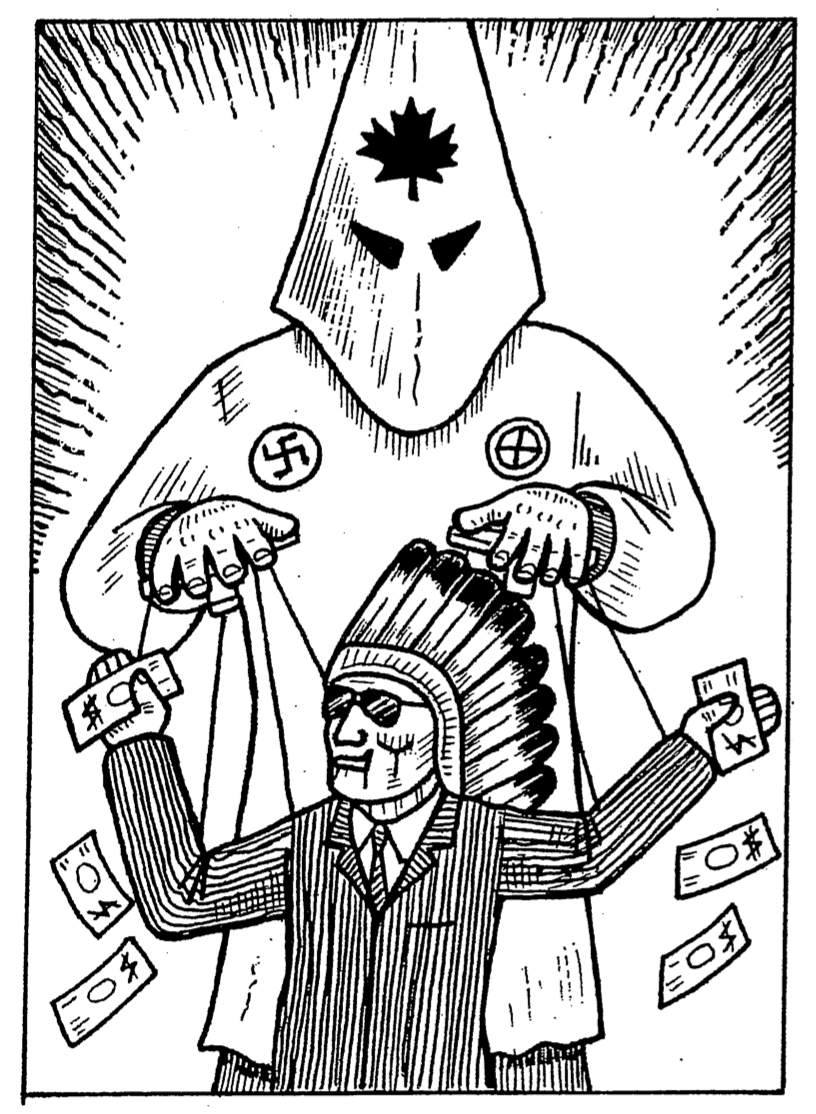
Neocolonialism means a 'new colonialism'. It involves the use of state-funded Native government, business, & organizations to indirectly control Indigenous people. In Canada, for example, the government spends billions of dollars annually to maintain a system of neocolonialism, funding band councils, Aboriginal political organizations, as well as social programs, arts & culture, etc.
"Neocolonialism involves the use of Natives to control their own people. In general, it means giving some of the benefits of the dominant society to a small, privileged minority, in return for their help in making sure the majority cause trouble..; the image of successful Aboriginals in government [helps] create the myth that all Natives have a place in the dominant society.
"The change from colonialism to neocolonialism is a change only in how the state controls the colonized people. Colonialism is a system in which the colonized people have no control over their lives- economically, socially, politically, or culturally. The power to make decisions in these important areas of daily life are almost totally in the hands of others, either the state or corporations & business... the state is willing to share some of the wealth of a racist system with a few Natives in return for a more effective method of controlling the majority.
"The most threatening & effective form of neocolonialism devised by the state has been its efforts to intervene & control popular Native organizations which had been previously independent. They began with core grants to help the associations organize; then the elected leaders of the organizations got larger & larger salaries- making them dependent on the state just as the Native bureaucrats in government were. As the years went by more money was provided to organizations- money for housing, economic development & service programs, etc.
"The most important effect of government funding, or state intervention, is that the state, by manipulating grants, can determine to a large extent what strategy the organizations will use. It is no coincidence that when organizations were independent of government money in the mid-sixties, they followed a militant strategy which confronted government. Now, after twenty years of grants, they are following a strategy that requires subservience to the state."
-- (Howard Adams, Tortured People; the Politics of Colonization, pp. 56-
57)
Pyramid of Power
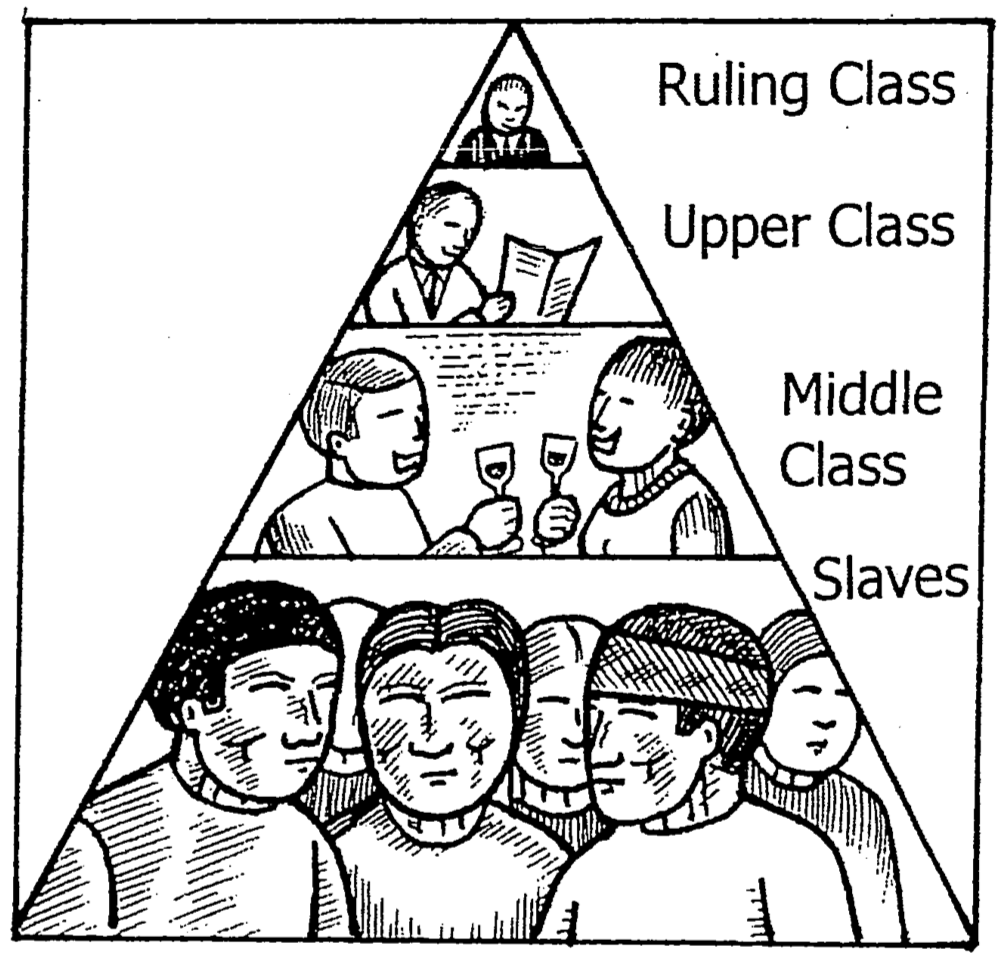
The structure of European society is, by its very nature, a system of oppression & control. It is organized in a pyramid structure, with a small elite at the top and the masses of people at the bottom. Indigenous peoples comprise the bottom layer of this pyramid, and it can be said that it is literally built on top of them (i.e., in Mexico City, the Presidential Palace is built on top of an Aztec temple).
The pyramid structure is one that reappears throughout civilization, reflecting the oppressive relationships & patterns upon which such societies are based. The patriarchal family unit, the government, the church, the army, the corporation; all share similar organizations of hierarchy, central authority, and control.
In society, one's position in this pyramid is determined by gender, race, and economic class; the global elite are overwhelmingly rich white males. They are the descendants of the European nobility and aristocracy established after the collapse of the Roman Empire. Their rise to global power as a class began with the 1492 invasion of the Americas. This class system is maintained in the interests of the rulers and is protected by national police and military forces (including courts & prisons).
Globally, the pyramid of power exists in the relations between nations; the predominantly Euro-American Group of Seven (the G7: Canada, France, Germany, Italy, Japan, United Kingdom and United States. With Russia it is the 08) control the international political and economic system. They are the top of the pyramid. Most of the world's countries are poor and impoverished, forming the bottom layers of the pyramid.
Sociological Impact
The sociological impacts of colonialism, those that affect the entire society/nation, include:
Genocide
According to Article 2 of the UN 1948 Convention on Genocide,
"Genocide means any of the following acts committed with intent to destroy, in whole or in part, a national, ethical,
racial or religious group as such:
(a) Killing members of the group;
(b) Causing serious bodily or mental harm to members of the group;
(c) Deliberately inflicting on the group conditions of life calculated to bring about its physical destruction in whole or in part;
(d) Imposing measures intended to prevent births within the group;
(e) Forcibly transferring children of the group to another group."
According to Article 4,
"Persons committing genocide or any of the other acts enumerated... 'shall be punished, whether they are constitutionally responsible rulers, public officials or private individuals."
Acts of genocide (as defined by the UN) are common to virtually all colonial invasions & occupations of Indigenous or sovereign territories. This can be seen in the patterns of military conflict (massacres, biological warfare, scorched earth), assimilation (residential schools), sterilization of Indigenous women, and fostering out of Native children.
Clearly, genocide has been, and is now being, committed against Indigenous peoples, including those in Canada & the USA. The most visible effects of this are the high rates of suicide, alcohol & drug addiction, mental disorders, poverty, internalized violence, &' imprisonment, among colonized Indigenous populations. These are a direct result of colonial oppression arising from political & economic policies.
That member states of the UN can so blatantly violate its conventions & international law, and yet retain their status and suffer no consequences, is due to the imperialist structure of the global system itself.
Loss of Territory and Sovereignty
Sovereignty is defined as a "supreme authority within a territory", free from external control & dependence. This definition is used to describe the international relations between nations, which are seen as sovereign entities having total independence and control over a certain territory.
A nation is often defined as a group sharing a common ethnicity, language, culture, history and territory. Today, terms such as country & state are also used to describe nations, but a nation is more correctly defined as a group of people, not a nation-state (which often contains many nations within its borders).
Along with internal governance & independence, a primary aspect of sovereignty is the ability to control who enters the territory. This control is necessary as a means of self-defense & security for the nation itself. In the face of armed aggression, this defense can only be carried out through some form of military force.
Although the term has its origins in European political terms, it is generally acknowledged that Indigenous nations had all the attributes of sovereignty prior to colonization. One of the earliest recognitions of this by colonial powers was in the process of treaty making (treaties being international agreements between two or more nations).
Today, terms such as First Nations & self-government imply some form of sovereignty. In the US, 'tribal sovereignty' is often used to describe the power of tribal governments on reserves. None of these terms, however, or the policies from which they are derived, have any basis in the actual exercise of sovereign power by Indigenous peoples.
Assimilation
Following the period of military invasion, and once an occupation has been established, surviving Indigenous populations are then subjected to policies of assimilation. This is only possible after their military defeat.
In many colonial situations, a first step in assimilation is to contain the surviving Indigenous populations in a reservation system (Le., the South African Bantustan, or reserves in North America). This is necessary to 'open up territory for settlement & exploitation, while providing a basis for systematic indoctrination into European society.
In many colonial situations, it is the Church and missionaries who begin the process of indoctrination. A common tactic is the forcible removal of children from their families and communities, and their placement in Church-run schools (i.e., missions, Residential or Industrial Schools, etc.).
A primary target for indoctrination are chiefs or high ranking families; once converted, they serve as useful collaborators, able to influence their communities and to mobilize resources.
Along with education, all aspects of the colonial society are utilized in a process of assimilation, i.e., political, economic, ideological, cultural, etc. The goal is to eradicate as much of the Indigenous culture & philosophy as possible, and to replace these with those of European civilization.
Assimilation is a final phase in colonization. What distinguishes it from the previous stages of recon, invasion & occupation is its primarily psychological aspects. It is not a military attack against a village, but a psychological attack against the mind & belief system of a people.
As a result of assimilation polices in Canada & the US, generations of Indigenous people have become increasingly integrated into European society. Since the 1970s, more Indigenous people have become professionals (lawyers, doctors, businessmen, etc.), and more have passed through universities or colleges. As a result of this increased training, band councils now self-administer government policies and are more involved in business & resource exploitation that at any time in the past.
While this is promoted as progress (and even 'decolonizaton'), it is actually greater assimilation into the colonial society. Overall, today's generations of Indigenous people show a greater degree of assimilation than previous ones. Some factors that account for this are the effects of residential schools, decline of culture, reduced reliance on traditional ways of life, greater dependence on the colonial system, increased urbanization, and ongoing exposure to Western culture through modem communications (TV, movies, music, printed material, etc.).
Individual Impact
Post-Traumatic Stress Disorder
Overall, Indigenous peoples can be said to suffer from Post-Traumatic Stress Disorder (PTSD), both as a group and as individuals.
"Traumatic events involve death or the threat of death; injury or the threat of injury. It is not just the events themselves but the experience of those events that makes them traumatic."
-- (Trust After Trauma, p. 339).
Some examples of traumatic events include war, natural disasters, physical or sexual assault, robbery, kidnapping, etc. PTSD is shared by many survivors of trauma, such as combat veterans, victims of torture, sexual or physical abuse, etc.
Colonization and genocide are examples of collective trauma that impact on a people's culture and identity, On an individual level, Indigenous people continue to suffer traumatic events, including widespread sexual abuse, domestic
violence, suicides, police violence, imprisonment, etc.
Symptoms of PTSD include depression, paranoia, panic & anxiety attacks, sleeping disorders, etc. Depression is characterized by strong feelings of worthlessness, hopelessness, fatigue, irritability, irregular sleep and an inability to feel pleasure. As well, many trauma survivors experience feelings of shame and guilt for being an 'unwilling accomplice' when forced to participate, endure, and/or witness traumatic events. Overall,
"One of the most profound losses trauma survivors experience is the loss of a positive self-image." -- (Trust After Trauma, p. 29)
Victims of traumatic events may have difficulty forming relationships based on trust, especially if the abuser was a family member. Women assaulted by men may have difficulty trusting any men. Survivors of trauma may have eating disorders and a pre-occupation with body image. Alcohol, drugs, and/or sexual promiscuity are some coping methods commonly used.
PTSD is just one of several possible reactions to trauma, including somatization (physical illness resulting from anger, pain, etc.), and disassociation (mentally blocking or 'forgetting' the traumatic event). In addition, trauma survivors must deal with disbelief: rejection and even hostility from family or community members (ie., blame the victim). If not rejected, survivors of trauma are expected to keep silent about their experiences, especially allegations of abuse involving community/family members.
Many, but not all, of the following individual impacts of colonialism can be traced to some form of Post Traumatic Stress Disorder.
Individualism, Identity an Inferiority Complex
With the breakdown of Indigenous society, nations & families also become broken & fragmented. European values of individualism & self-interest (essentially capitalist) increasingly replace traditional Indigenous values of community & collectivity. In fact, the entire fabric of Indigenous culture & society is torn apart:
"Colonial domination, because it is
total and tends to over-simplify, very soon
manages to disrupt in spectacular fashion the
cultural life of a conquered people. This
cultural obliteration is made possible by the
negation of national reality [loss of
sovereignty], by new legal relations
introduced by the occupying power [i.e., the Indian Act], by the banishment of the natives and their customs to outlying districts by colonial society [reservations], by expropriation [theft], and by the systematic enslaving of men & women."
-- (Frantz Fanon, Wretched ofthe Earth, p. 236)
Alongside the breakdown of family & community is the loss of culture. When confronted with systematic assimilation into European culture, the result is a loss of identity & feelings of inferiority:
"Every effort is made to bring the colonized person to admit the inferiority' of his culture which has been transformed into instinctive patterns of behavior, to recognize the unreality of his 'nation', and, in the last extreme, 'the confused and imperfect character of his own biological structure."
-- (Frantz Fanon, Wretched of the Earth, p. 236)
Internalized Violence
As a result of the physical and psychological affects of colonialism, patterns of internalized violence and crime are established. The colonized tend to attack and victimize their own. These attacks range from violent assaults and murder, to petty theft and vandalism. These patterns are common among colonized peoples (i.e., a leading cause of death among young black males in the US are black males).
One reason the colonized prey on one another is that of proximity; one's family & community are right there, while the oppressor lives in another world. The physical realities of colonialism, the establishment of reserves and urban ghettos, along with an apartheid system, separates the colonized and the settler communities.
More than the physical proximity of one's own people, however, is the psychological impact of colonization. Not only is the settler community physically distant, it is also foreign and threatening. It is well guarded. The penalties for violating the settler's person or property are more severe than for violating one's own.
Many forms of internalized violence arise from European colonial society itself. Widespread sexual abuse among Indigenous peoples in Canada and the US, for example, was first introduced through the Residential School system. Children who experienced abuse by school staff (priests & nuns) returned to their communities and began abusing their own family members, resulting in intergenerational patterns of abuse that continue to this day.
Alcohol, Drugs and Suicide
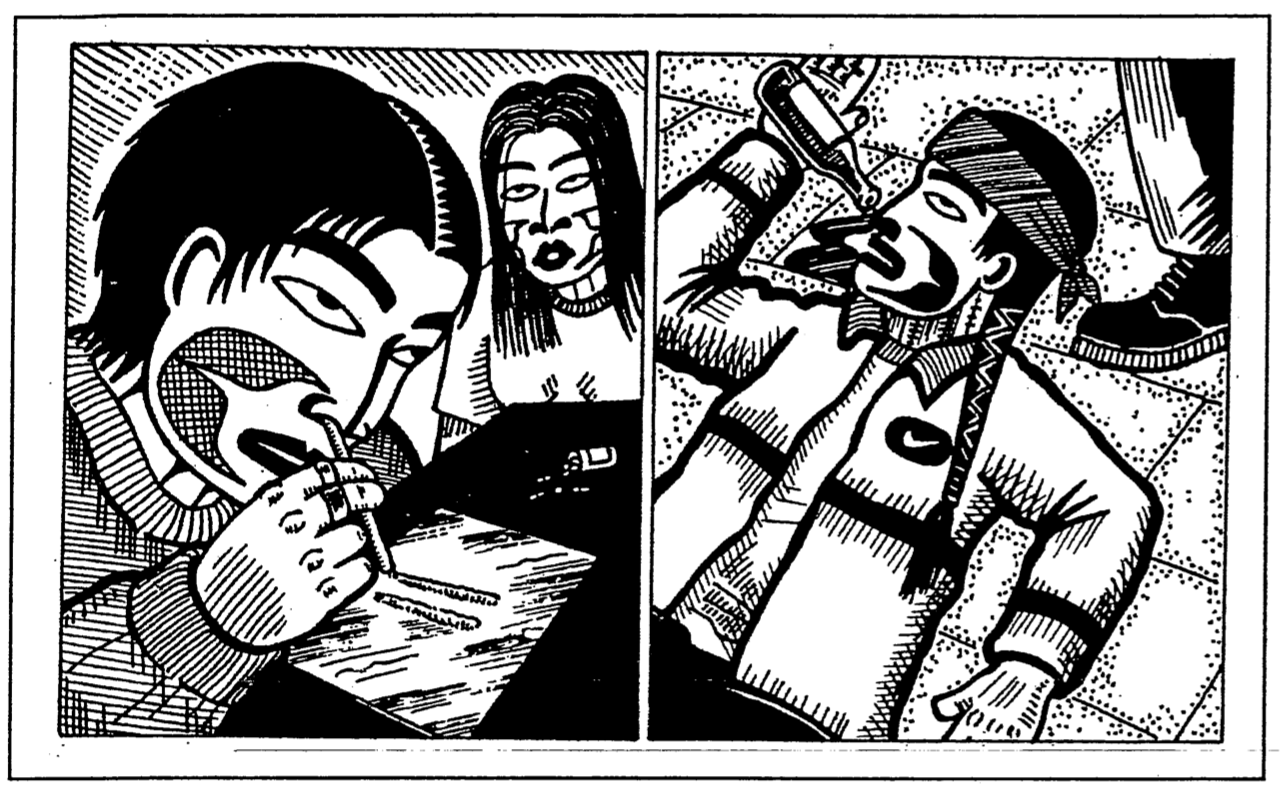
Arising from the oppressive social conditions that colonialism creates (i.e., poverty, loss of identity, feelings of inferiority, etc.), Indigenous peoples suffer from high rates of alcoholism, drug addiction, and suicide, in both rural and urban communities. These are common methods of temporarily escaping the oppressive routines of day-to-day life, of suppressing trauma or tension, or ending feelings of despair and hopelessness (suicide).
High rates of violent death & imprisonment among Indigenous peoples are both attributed to alcohol and drug abuse. In Saskatchewan, a study found that alcohol was involved in 45% of suicides among those 15-34 years of age; 92% of fatal motor vehicle accidents, over 38% of homicides, and over half the deaths by fire and drowning ((First Nations in Canada, p. 86).
Rates of suicide among Indigenous peoples in Canada are estimated at 33 per 100,000 population, compared to the national average of 13 per 100,000. Among Indigenous youth 15-24 years of age the rate is 114 per 100,000, compared to 26 per 100,000 among the general population (First Nations in Canada, p. 83 & 85).
According to the Royal Commission on Aboriginal Peoples, a multi-million dollar investigation into the conditions of Indigenous peoples in Canada,
"We have concluded that suicide is one of a group of symptoms ranging from truancy & law breaking to alcohol and drug part interchangeable as expressions of the
burden of loss, grief, and anger experienced by Aboriginal people in Canadian society"
--(RCAP, 1995:90, quoted in First Nations in Canada, p. 83).
Health
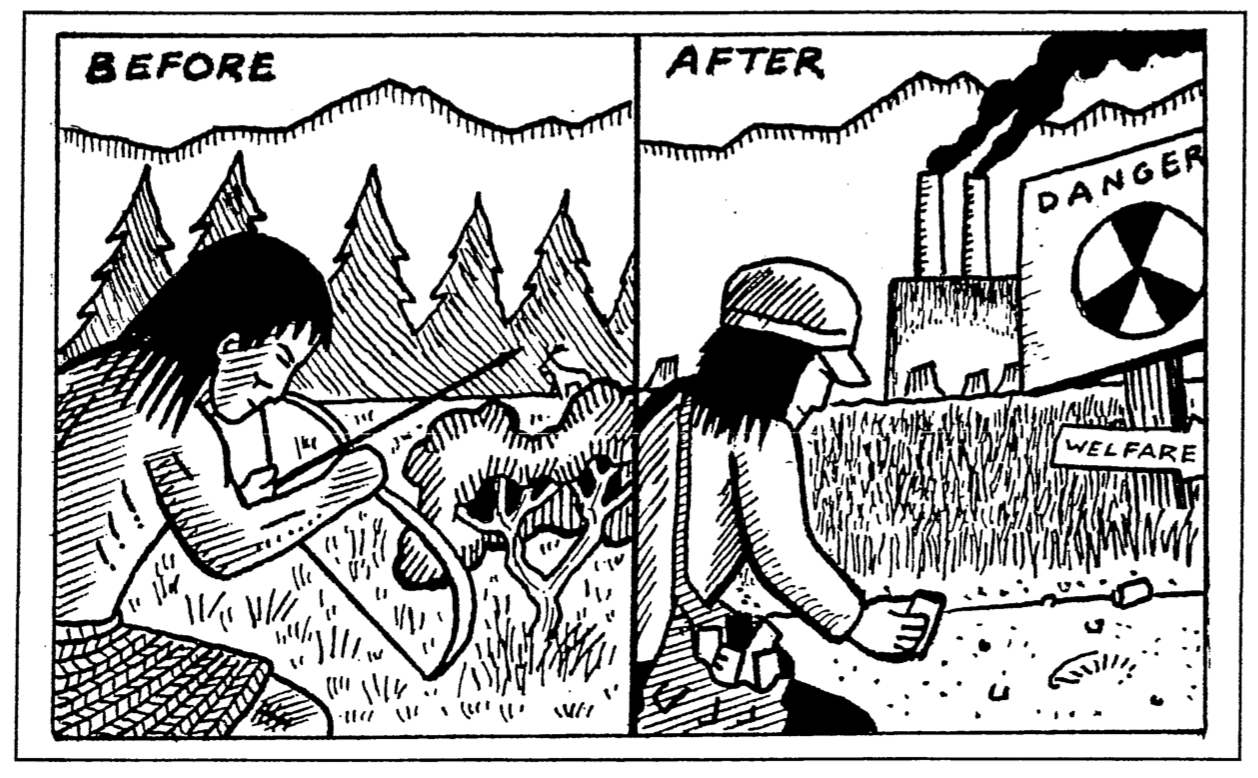
A primary argument in favour of colonialism was that it brought the benefits of civilization to Indigenous peoples, greatly raising their standard of living. The genocidal practices of colonialism easily dismiss such claims, and yet they persist, based largely on an incorrect view that Native peoples barely managed to survive, scraping out a meager existence and victim to all sorts of injury, disease and death. In fact,
"Anthropologists have long recognized that undisturbed tribal peoples are often in excellent physical condition"
-- (Victims of Progress, p. 144)
Colonialism, far from raising the living standard of Indigenous peoples, instead plunges them into economic impoverishment, disease, and rapidly deteriorating health conditions. Drastic changes in diet resulting from limited access (or destruction) of traditional food sources, & dependence on European food items, has caused extensive health problems for Indigenous peoples.
After exposure to white flour, sugar, milk, etc., Indigenous peoples began to suffer rapid tooth decay and mouth diseases. After generations of dependence on European food products, Indigenous and other colonized peoples today suffer from high rates of diabetes, obesity, high blood pressure, and heart problems. Indigenous peoples also suffer the highest rates of diseases such as tuberculosis, pneumonia, cancer, AIDS, hepatitis, etc.
In Canada, the leading cause of death among Indigenous peoples is categorized as resulting from injury, primarily motor vehicle accidents. As the Saskatchewan example shows, most of these deaths result from alcohol abuse. Death by injury accounts for more than one-quarter of all deaths among Indigenous peoples, with a rate of 148 per 100,000, compared to the national average o f 46.9 per 100,000 (First Nations in Canada, p. 81).
The next most common cause of death are diseases of the circulatory system (i.e., heart attacks). This accounts for about two thirds of all deaths among Indigenous peoples. Rates of tuberculosis are approximately 47 per. 100,000, compared to the national average of 7.2 per 100,0000. Diabetes has been described as one of the most prevalent chronic health problems among Indigenous peoples, causing numerous side effects including heart and circulatory disease, blindness, kidney and nerve damage, and obesity.
Malnutrition, especially from protein deficiency, has become a major problem for Indigenous peoples around the world. In addition, poor health is compounded by conditions of urbanization & poverty, poor sanitation & housing, stress & trauma, as well as high levels of alcohol & drug abuse.
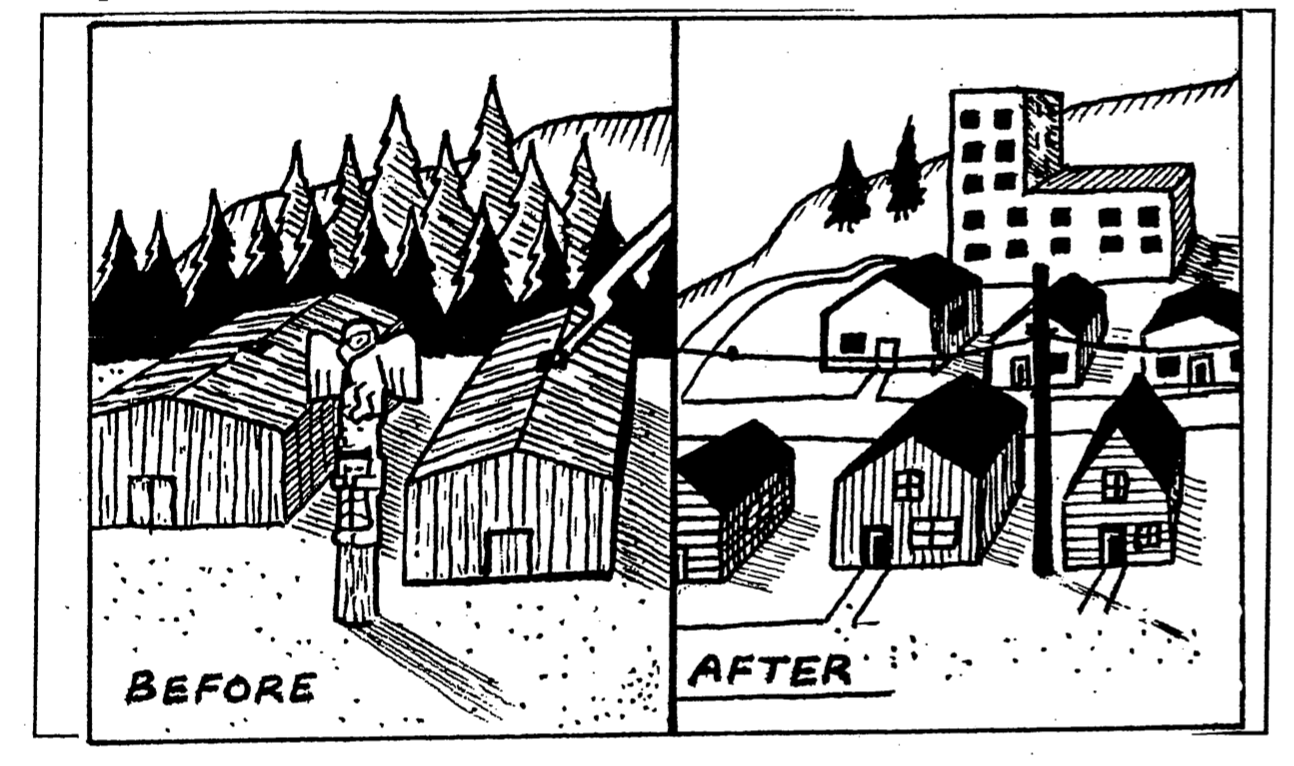
Exposure to industrial pollutants, including chemicals such as mercury, cyanide, and uranium, as well as fertilizers, has also had disastrous impacts on the health of Indigenous peoples. In areas of extensive mining, industrial production (i.e., pulp mills, oil & gas wells), or agriculture, for example, Indigenous peoples suffer high rates of cancers, birth defects, stillborns, etc. This is a result of their proximity to natural resource exploitation, exposure to contamination through water and the food chain (hunting & fishing), and lack of access to healthcare.
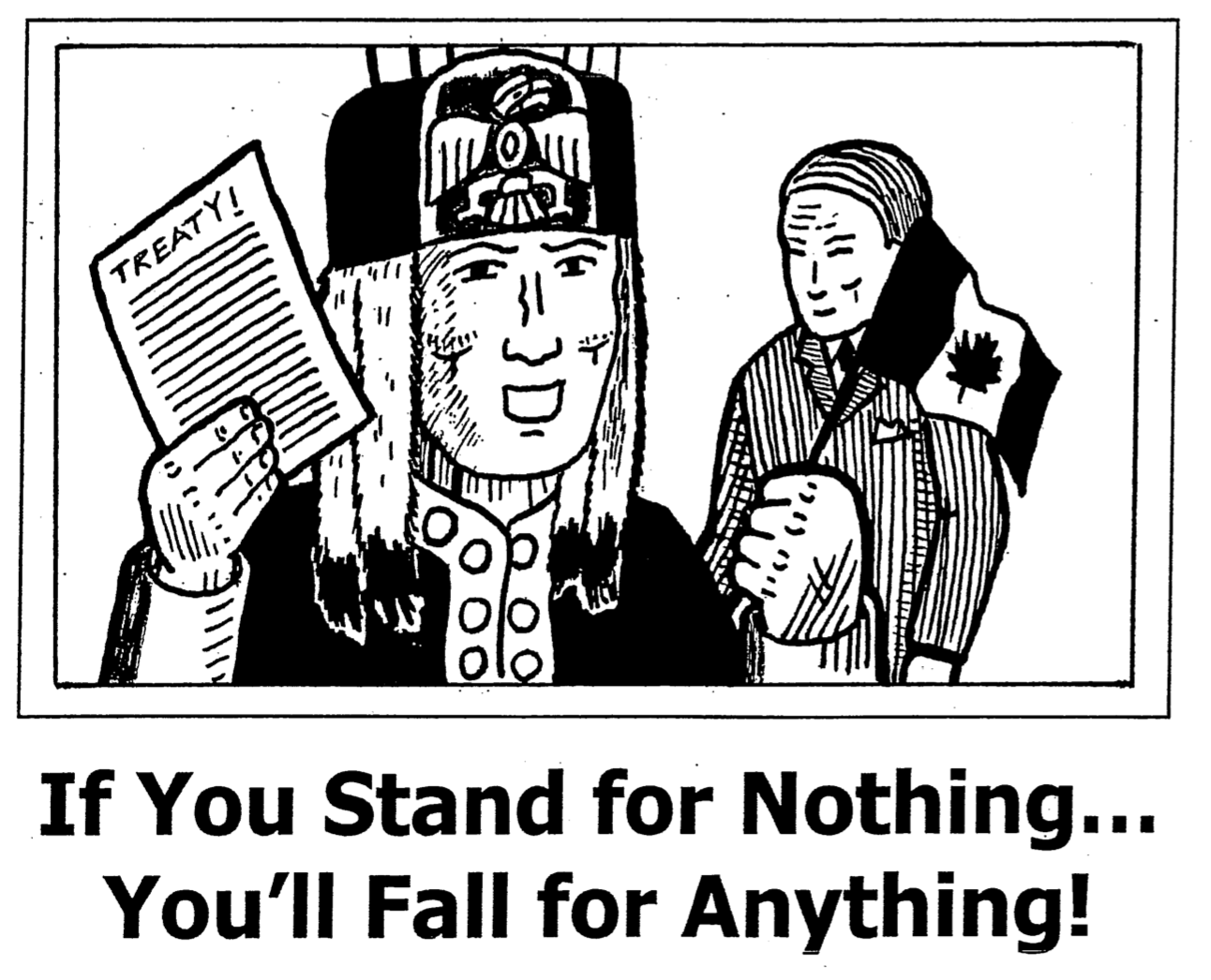
Decolonization
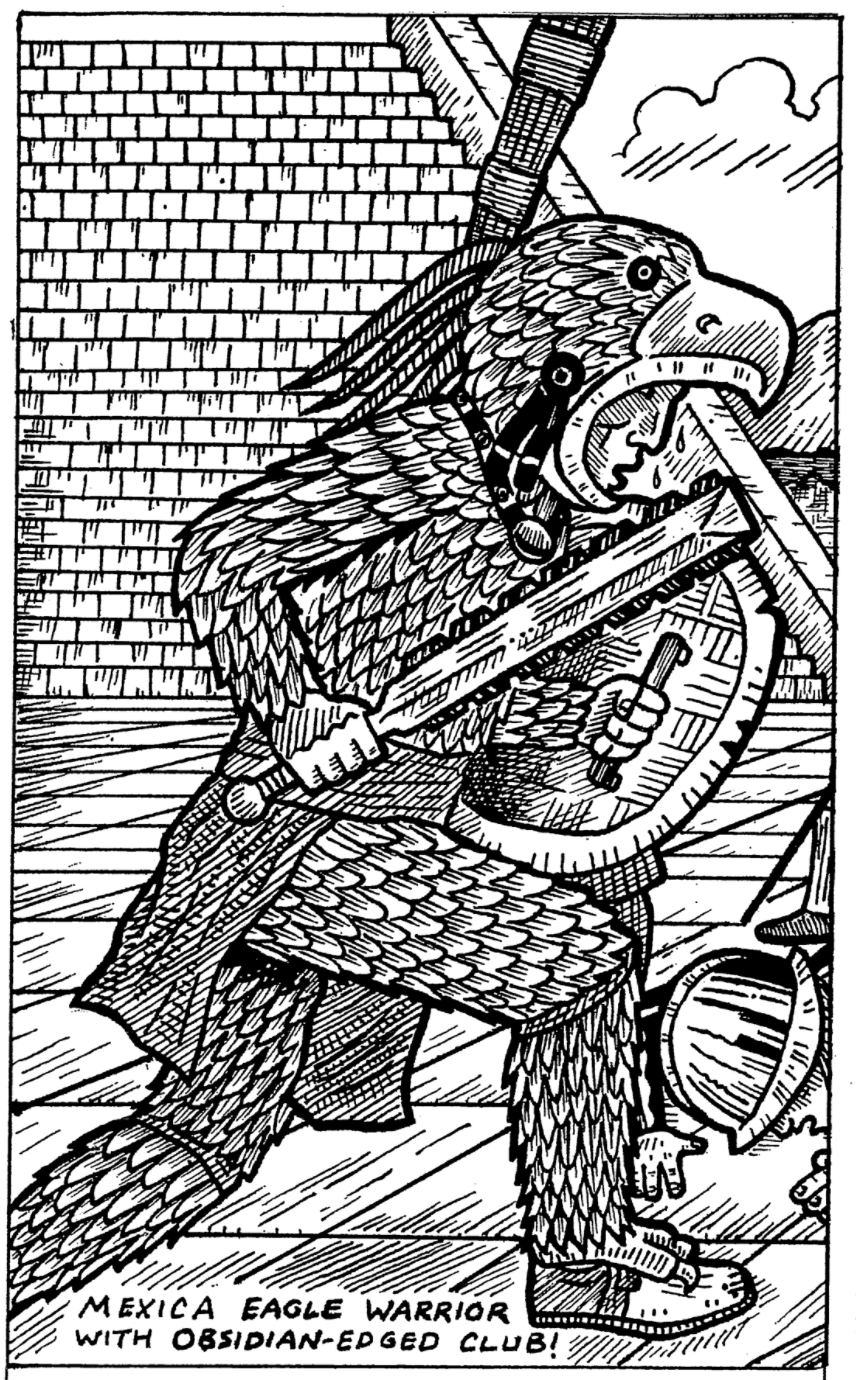
Decolonization is the ending of colonialism and the liberation of the colonized. This requires the dismantling of the colonial government and its entire social system upon which control & exploitation are based. Decolonization, then, is a revolutionary struggle aimed at transforming the entire social system and re- establishing the sovereignty of tribal peoples, In political terms, this means a radical de-centralization of national power (i.e., the dismantling of the nation-state) and the establishment of local autonomy (community & region, traditionally the village and tribal nation).
Any discussion of decolonization that does not take into consideration the destruction of the colonial system & the liberation of land & people can only lead to greater assimilation & control. The demand for greater political & economic power by chiefs & councils, although presented as a form of decolonization (i.e., "self-government"), only serves to assimilate Indigenous peoples further into the colonial system.
Just as colonialism enters and passes through various phases, beginning first with recon missions and then the application of military force, so too does decolonization. It would be a mistake to conceive of decolonization as a single event. Instead, it is a process that begins with individuals & small groups. The primary focus in the first phase of decolonization is on
.disengaging from the colonial system" and re-learning one's history, culture, etc. This phase places a heavy emphasis on rejecting European society & embracing all that is Indigenous as good & positive.
Some common steps in this phase include returning to one's community, re-establishing family relations, re-learning culture (inc. art, language, songs, ceremonies, hunting, fishing, etc.). This not only counters the destructive effects of colonialism, but also instills in the Indigenous person a greater respect &
appreciation for their own culture and way of life. In many ways it is a struggle for identity & purpose. While this is a crucial first step in any decolonization process, without the infusion of radical & revolutionary analysis, however, the focus on cultural identity in and of itself does not necessarily lead to anti-colonial consciousness. In fact, this focus on 'culture' alone can easily lead to conservative and even pro-colonial sentiments.
Empowered by their renewed cultural identity, one frequently drawn from a mish-mash of tradition, Christianity, and New Age spirituality, the 'decolonized' individual begins to believe that nothing has really changed, that they are in fact living the way of life of their ancestors, albeit in a very different world, They rationalize their relationship to the colonial world as one of supreme adaptation, while at the same time pitting their 'personal power' against the power of the system. In this fantasy world, inspired in no small part by the system itself, the spiritualists believe that through prayer and ceremonies alone everything will work out just fine.
The influence of New Age spirituality and Christianity among Indigenous peoples is not hard to find. Arising from the European slave society, these religious ideologies teach obedience and submission to authority, including the principle of non-violence in the face of violent repression (a tactic of the weak elevated to a moral or spiritual principle). When confronted with the overwhelming oppression & destruction perpetuated by the system, the New Age spiritualists retreat into their fantasy world, where all conflict is resolved and there are no distinctions made between oppressor and oppressed.
From the very outset, then, there is a possibility for co-optation of the decolonization efforts made by individuals. This co-optation is, in part, engineered by the colonial system in the form of funding & publicity for cultural programs, educational materials, etc., and official recognition of high profile collaborators as 'spiritual leaders'.
After the collaborators involved in the Indian Act band council system, the spiritualists are often the most vocal opponents of anti-colonial resistance at the community level. They are influenced & manipulated by the political leaders to fulfill this role, and at the same time act according to their own logic, which is essentially conservative. While they actively oppose organized resistance, they are silent in regards to colonial oppression and advocate maintaining the status quo (conservatism). How is it possible that Indigenous culture, the basis for decolonization, can be so easily co-opted?
Culture & the Struggle for Liberation: Fanon
Frantz Fanon (1925-1961) was an African intellectual and psychologist, involved in Algeria's war for independence in the 1950s. His analysis of colonialism and its effects on colonized peoples have had a profound impact on anti-colonial resistance movements around the world. For Fanon, culture was a vital part of this resistance.
As noted, Indigenous culture is a primary means of decolonization. It is both a link to our ancestral past and to another way of thinking, of seeing the world. It is the essence of our identity as Indigenous peoples and a vital part of challenging colonial ideology. Yet, as Fanon and others have observed, this culture, when not totally erased, is warped & distorted by the colonial society:
"The colonial situation calls a halt to national culture in almost every field... By the time a century or two has passed there comes about a veritable emaciation [starvation, or thinning out] of the stock of national culture. It becomes a set of automatic habits, some traditions of dress and a few broken-down institutions. Little movement can be discerned in such remnants of culture; there is no real creativity and no overflowing life.· The poverty of the people, national oppression and the inhibition of culture are one and the same thing. After a century of colonial domination we find a culture, which is rigid in the extreme, or rather, what we find are the dregs [left-overs] of culture, its mineral strata. The withering away of the reality of the nation and the death-pangs of the national culture are linked to each other in mutual dependences."
-- (Frantz Fanon, Wretched of the
Earth, p. 237-38)
Here, Fanon describes the effects of colonization on culture. Its natural development, the incorporation of new experiences, etc., are more or less stopped at the point of contact. In many ways, it is the colonial power (or anthropologists, etc.) that comes to define what is traditional and what is not. The colonized, in an effort to retain traditional culture, at the same time also stop its development and impose strict limits on interpretation in an effort to retain an imagined 'purity'. While superficial aspects of culture remain, the essence & vitality of the culture itself are lost or minimized (think pow-wow, or consider the influences of Christianity & New Age 'spiritualism' on Indigenous culture).
An important point Fanon makes is that a people's culture is directly linked to the physical world: the colonial occupation of a nation's territory is total, affecting everything & everyone. According to Fanon, it is the anti-colonial resistance that revitalizes the culture of the colonized:
"It is the fight for national existence which sets culture moving and opens to it the doors of creation... We believe that the organized undertaking by a colonized people to re-establish the sovereignty of that nation constitutes the most complete and obvious cultural manifestation that exists. It is not alone the success of the struggle, which afterwards gives validity and vigor to culture; culture is not put into cold storage during the conflict. The struggle itself in its development and in its internal progression sends culture along different paths and traces out entirely new ones for it. The struggle for freedom does not give back to the national culture its former value and shapes; this struggle which aims at a fundamentally different set of relations between [people] cannot leave intact either the form or the content of the people's culture. After the conflict, there is not only the disappearance of colonialism but also the disappearance of the colonized..."
-- (Frantz Fanon, Wretched o fthe Earth, p. 244-45)
In the process of struggle, the culture of the colonized is transformed into the means of resistance, incorporating new forms of expression and interpreting traditional culture in order to make it relevant to the new colonial reality (and present generations). Fanon uses the examples of literature, oral tradition, crafts, dances, songs & ceremonies, which develop alongside the anti-colonial resistance:
"While at the beginning the native intellectual used to produce his work to be read exclusively by the oppressor, whether with the intention of charming him or of denouncing him ... now the native writer takes on the habit of addressing his [her] own people... This may be properly called a literature of combat, In the sense that it calls on the whole people to fight for their existence as a nation...
"On another level, the oral tradition-stories, epics and songs of the people-which formerly were filed away as set pieces are now beginning to change. The storytellers who used to relate inert episodes now bring them alive and introduce into them modifications which are increasingly fundamental. There is a tendency to bring conflicts up to date and to modernize the kinds of struggle which the stories evoke, together with the names of heroes and the types of weapons. The method of allusion is more and more widely used. The formula 'This all happened along ago' is substituted by that of 'What we are going to speak of happened somewhere else, but it might well have happened here today, and it might happen tomorrow'. The example of Algeria is significant in this context. From 1952-3 on, the storytellers, who were before that time stereotyped and tedious to listen to, completely overturned their traditional methods of storytelling and the contents of their tales... Colonialism made no mistake when from 1955 on it proceeded to arrest these storytellers systematically.
"The contact of the people with the new movement gives rise to a new rhythm of life... Well before the political or fighting phase of the national movement an attentive spectator can thus feel and see the manifestation of new vigor and feel the approaching conflict. He will note unusual forms of expression and themes which are fresh and imbued with a power which is no longer that of invocation but rather of the assembling of the people, a summoning together for a precise purpose. Everything works together to awaken the native's sensibility, and to make unreal and unacceptable the contemplative attitude, or the acceptance of defeat... The conditions necessary for the inevitable conflict are brought together."
-- (Frantz Fanon, Wretched of the Earth, p. 240-41)
If we accept Fanon's analysis - as correct, culture is indeed the basis of decolonization. As this resistance grows and expands, it not only re-applies traditional culture but revitalizes it, frequently adapting new forms of expression, as part of the decolonization process.
A primary example of this cultural shift, of new forms of expression & vigor' that reveal the "approaching conflict" can be seen in the Mohawk resistance at Kanesatake/Oka in 1990. Similar in many ways to Native blockades & protests which began in the 1960s period, Oka served to renew not only the concept of sovereignty, but in particular a warrior culture charged with the responsibility of defending people & territory.
Extensive media coverage of the Oka Crisis, including images of armed, masked warriors and the Warrior Unity flag, set the tone for Indigenous resistance throughout the 1990s, inspiring many Indigenous people and communities, instilling in them a warrior culture adapted to the realities of modern-day colonialism.
When considering the process of decolonization and the tendency for many Indigenous people to become co-opted even when engaging in traditional cultural practices, a primary element we find lacking is that of the warrior. This occurs for various reasons, including the idea that such a culture is no longer necessary (i.e., the idea that 'modern-day' warriors are now lawyers & businessmen), that such a culture is criminal (state propaganda), or that warriors and the very idea of conflict are somehow anti-spiritual (New Age/Christian pacifism).
By discarding the single most important element of Indigenous culture in regards to self-defense & survival, modem-day spiritualists & reformers reveal their inability to comprehend the full nature & extent of the problem confronting Indigenous peoples and the earth. The culture they promote is that which Fanon warns us of: superficial, lacking vitality, "rigid in the extreme." Influenced by New Age/Christian ideologies, they also preach submission to oppression & exploitation.
Warrior Culture & Fighting Spirit
Decolonization, then, begins with culture. But in order to meet the objective of
decolonization (liberation of land & people), this culture must of necessity include that of the warrior. Without this, all efforts at decolonization will be vulnerable to co-optation and assimilation. This is because the warrior symbolizes & represents resistance & fighting spirit.
When we consider the impacts colonialism has had on Indigenous peoples, including post-traumatic stress disorder, identity crisis, feelings of inferiority, etc., it is no surprise that our communities are afflicted with such high rates of alcoholism, drug addiction, interpersonal violence and overall dysfunction. The most extreme impact is perhaps that of suicide among Indigenous youth.
These are the symptoms of a broken and defeated people, so colonized that they are unable to comprehend the means by which they have, in fact, been colonized. While history and analysis can awaken people to the realities of colonial oppression, it is the suppressed culture of the warrior that can provide the necessary fighting spirit to motivate people into action. This is why warrior societies, organization and culture were so ruthlessly attacked by early colonial forces, and why today they remain a primary target for state repression & propaganda.
From the very outset, then, the warrior culture must be emphasized as part of any decolonization effort. This includes the traditional responsibilities, organization and methods of warrior societies, along with songs, crests, regalia etc. Today, this warrior culture also includes camouflage fatigues, masks, and direct action (blockades, occupations, etc.), along with specific groups and a recent history of resistance (i.e., the 1960's Red Power, American Indian Movement, Mohawk Warrior Societies, aka, Gustafsen Lake, Ipperwash, and the Native Youth Movement). All of these should be used to raise the morale and fighting spirit of our people, and especially the youth.
Identifying the Enemy
Along with fighting spirit, identifying the enemy is another important aspect of decolonization. Without this, the root cause of our oppression cannot be clearly understood, nor can the means of liberation be seen. Although we can say that the colonial society is itself the enemy, including all those who participate in & maintain the system, such a view is far too vague & implies that all European settlers are our enemies. It fails to account for internal divisions within the society, particularly those based on economic class, and limits our ability to expand resistance into the lower ranks of the settlers themselves.
If we see Western society as essentially a slave system, then there are rulers and those who are enslaved. Even if many are unaware of their own oppressed condition, the fact that there are rulers and slaves reveals a fundamental division within the society. We should seek to exploit this division by identifying potential alliances, thereby strengthening our forces and weakening those of our enemy.
Our common enemy is clearly the ruling class, which organizes and directs the system of exploitation, oppression, and control. The means by which this is accomplished is through the government and corporations, who work hand in hand to ensure that the entire system continues to function. The government organizes and imposes control over the population, in order for the maximum profits to be made by corporations.
In essence, then, our position is one of class war, and our common enemy is the ruling class based in the government & corporations.
Disengaging from the Colonial System
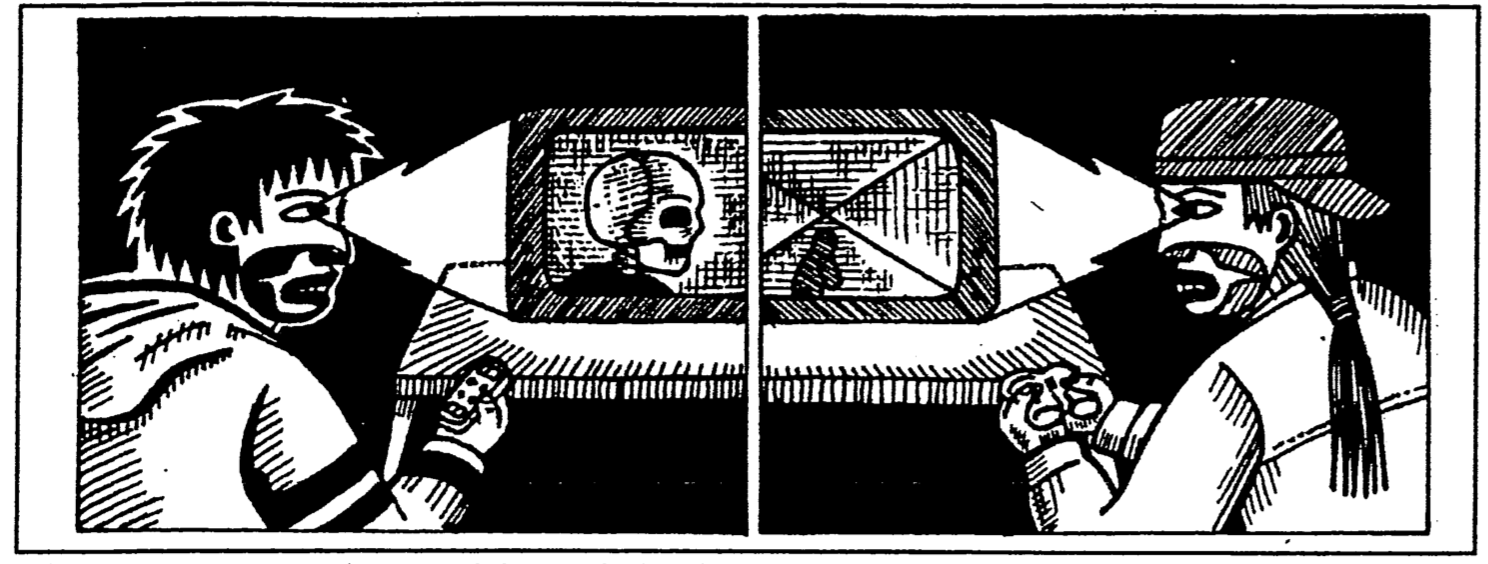
When we say we are in a war for territory, it must be understood that this is a total war, and that the territory is not only physical. Today, this territory also includes the mental and psychological landscape. In fact, our main enemy at this time is not colonial troops or police, but instead the ideology of the system itself, the primary means by which social control is maintained.
This colonial ideology is transmitted through a variety of means, including schools, TV, corporate media, movies, and pop music (including mainstream rap). Through these, the values and way of life of the oppressor (ie., individualism, greed, materialism, patriarchy, etc.) are imposed. Even in the most remote reservation communities, the colonial way of life can be seen: a daily routine of watching TV & videos; playing video games, or listening to pop music.
An important step in breaking the mind control that has been imposed is limiting exposure to these forms of communication. Put the TV, the VCR, and the video games away. Tum off the radio. Organize activities that do not center on these forms of 'entertainment' or 'education.' Find positive alternatives such as videos and music that truly educate and inspire.
Another aspect of the daily routine of colonial society is alcohol & drugs. Despite the destructive effects on society overall, alcohol & drugs are both promoted by the system as forms of 'recreation' and the release of stress. We can see this in the 9-5 work routine, in which the tired worker returns home to relax by drinking a six pack (i.e., Homer Simpson), as well as in the five day work week, in which weekends are seen as 'party time'. Even those without jobs conform to this routine, in which Fridays and Saturdays are seen as 'party nites'.
Breaking these routines, disengaging from the system, is an important first step in decolonizing. It must be emphasized, however, that the objective is to limit exposure, not to cut ourselves off completely. To do so would only isolate us from the outside world and reduce our situational awareness. We need to know what our enemy is saying and doing in order to counter his efforts. At the same time, we
must keep 'up to date' with sociological trends & patterns, in order know the spirit ofthe time & conditions.
Along with this, there is the ongoing need to organize the resistance movement. Isolating ourselves from the colonial society, in an effort to decolonize our minds, bodies & spirits, limits our ability to gather information, communicate, and organize. We will, of necessity, continue to use modern technological tools in our organizing so long as such means continue to function. Our objective is the liberation of land & people, not the life-long pursuit of our individual decolonization. The return of the Indigenous person living in accord with the natural world, living a free, sovereign life, will only occur after the destruction of the colonial system. We should have no illusions about this, and it is in any case a fulfillment of our obligations to the future generations that they live such a life.
A 'slave cannot live as a free person until he or she has been liberated. The near-constant interaction with the slave-master, the daily routine of slavery, exploitation, & control, these are the conditions that create the need for liberation in the first place. Although we can, and do, struggle for the liberation of mind & spirit, it is a choice few are able to make. The vast majority are so indoctrinated & assimilated that they accept things as they are, both participating in, and perpetuating, the system itself.
Nevertheless, our task is to liberate the slaves & destroy the system. And we can only do this as we liberate our mind & spirit. This is why the personal journey of decolonization is not only logical as a starting point, it is also necessary. But it has its limitations. Although the total rejection of all European culture, including reading & writing, TV, etc., is correct in principle, we can see how, in practise, it limits our ability to organize and therefore fails to meet the primary objective (liberation of land & people).
Now we turn our attention to this first, crucial step: the liberation of mind & spirit.
Liberation of Mind & Spirit
The pervasiveness of the colonial system, its ability to penetrate virtually all aspects of our daily lives, including relationships, values, beliefs, etc., should not be underestimated. From the moment we are born, the process of socialization begins which has as its goal the production of obedient worker-slaves. Exposure to corporate entertainment, in the form of Hollywood movies, sports, music, etc., for example, begins at an early age. The educational system then provides a systematic means by which indoctrination is imposed.
Generally, all throughout one's childhood and youth, one is exposed to the system's ideology and way of life. Only later is the full extent of this indoctrination realized, if at all. Almost everything we are taught or told about society and the world we live is then seen to be a matrix of lies & deception. This is the realization that must be reached in order for us to even consider the concept of decolonization.
In this initial step at decolonization, we seek to disengage from the colonial system and to immerse ourselves in our own culture & way of life. This provides us with a positive alternative to the system, as our struggle is between two opposing & contradictory ways of life. As noted previously, however, there is a danger of co-optation without the influence of our warrior culture and the identification of a common enemy.
Relearning one's culture occurs through a variety of means. Participating in cultural activities, ceremonies, learning songs & dances, language, arts & crafts, traditional skills such as hunting & fishing, and living on the land, are some examples. In the late 1800s, anthropologists made a concerted effort to document our cultures in the belief that we would disappear as distinct tribal peoples. Their research, while serving the interests of the colonial system, also contains vast amounts of ancestral knowledge provided by Indigenous informants. This information, acquired through reading & study, is a source of decolonization that should be exploited.
One of the most important methods of liberating our mind &. spirit is participating in ceremonial activities. Many Indigenous people recovering from alcoholism & drug addiction turn to ceremonies for healing, and we should apply the same rationale in regards to decolonization. Common examples in North America include sweatlodges, fasting, potlatches, peyote, yuwipi, cold-water bathing, sundances, etc. Whatever the form, these ceremonies share some common characteristics such as the need to endure periods of discomfort or suffering, isolation, sleep deprivation, etc., all of which serve to alter one's mental state and to open up channels for spiritual communication.
Ceremonies also instill positive values such as sacrifice, discipline, self-control, humility, and the ability to withstand hardship. These values are essential parts of our warrior culture and it can be said that through these a warrior spirit permeated all aspects of traditional Indigenous society. Contrasted with European values of individualism, greed, and materialism, we can see how ceremonies contain within them the potential to radically alter an individual's way of life & perception of the world.
Active Use of Territory
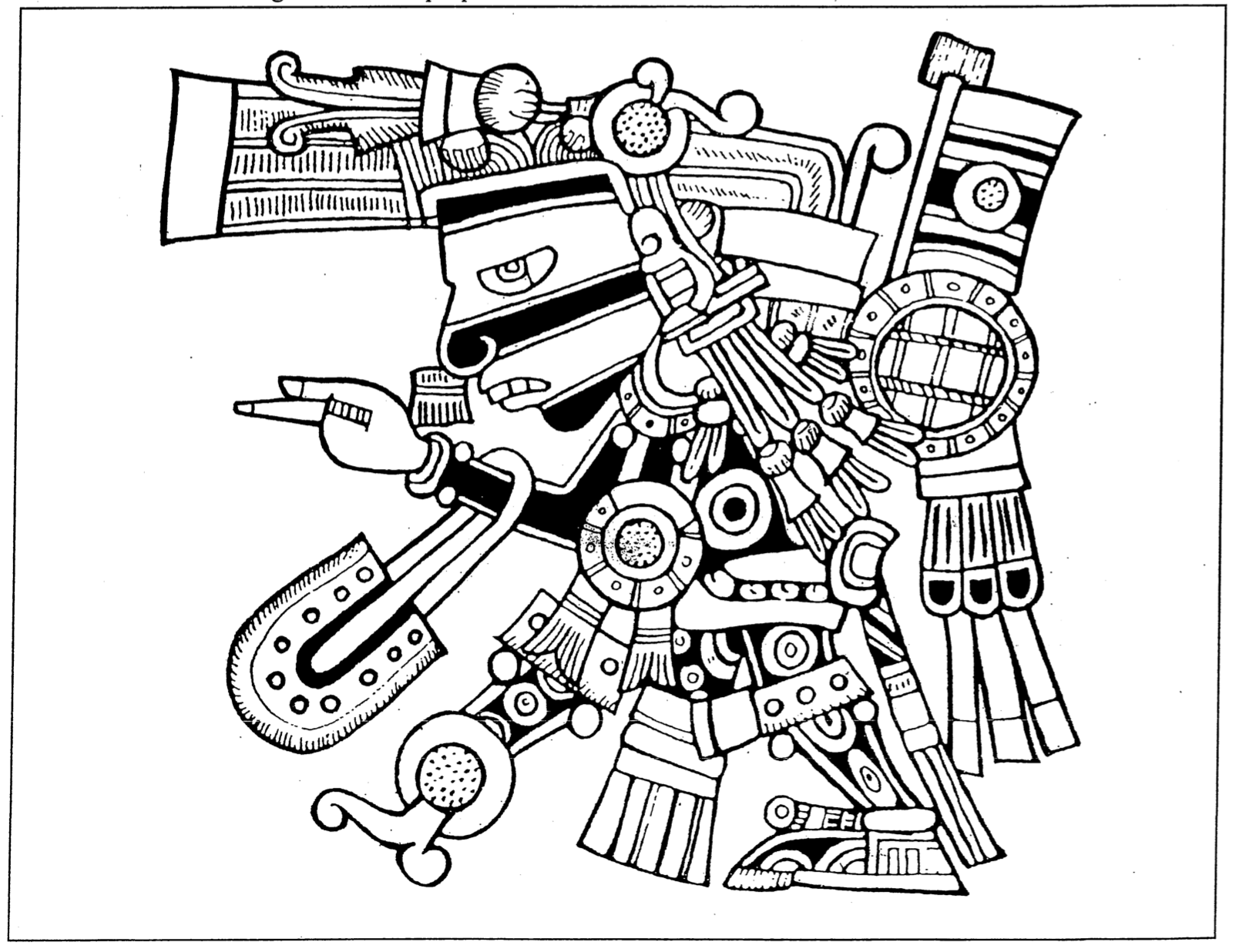
When individuals begin the process of decolonization, disengaging from the system and immersing themselves in their own culture, activities out on the land & away from the urban/suburban environment increase. This is in accord with our strategy of disengagement and immersion in regards to personal decolonization. At the same time, the land is, in and of itself: a powerful method of liberating one's mind & spirit.
One of the most crucial understandings of the colonial system is that it is an alien system, not only in that it comes from an external force (Europe), but also in the way that it is completely alienated and removed from the natural world. Civilization is a man-made system that today permeates all aspects of our lives, alienating us from the natural world.
The land is not only necessary for our survival & sustenance as Indigenous peoples, providing us with food, water, 'shelter, clothing, tools, etc., it is also the source of our culture. The environment we live in affects our mind & spirit. In the urban culture of Western society, the natural world is something to be feared, conquered, and exploited (this is a basic
message of Christianity); only by first alienating its own citizens from the land can such a perspective be accepted as true & logical. In contrast, Indigenous culture is part of the natural world; forces of nature, animals & plants, all these form integral parts of the culture that can only be understood by being out on the land.
Active use of territory is also a method of monitoring, and thereby defending, one's national territory. Regularly patrolling one's territory, by hiking, hunting, camping out, etc., can be seen as a form of asserting sovereignty. Even more so is the active defense of territory through re-occupation camps or the construction of traditional shelters. These types of activities also involve larger numbers of people in decolonization efforts.
Decolonization in North America
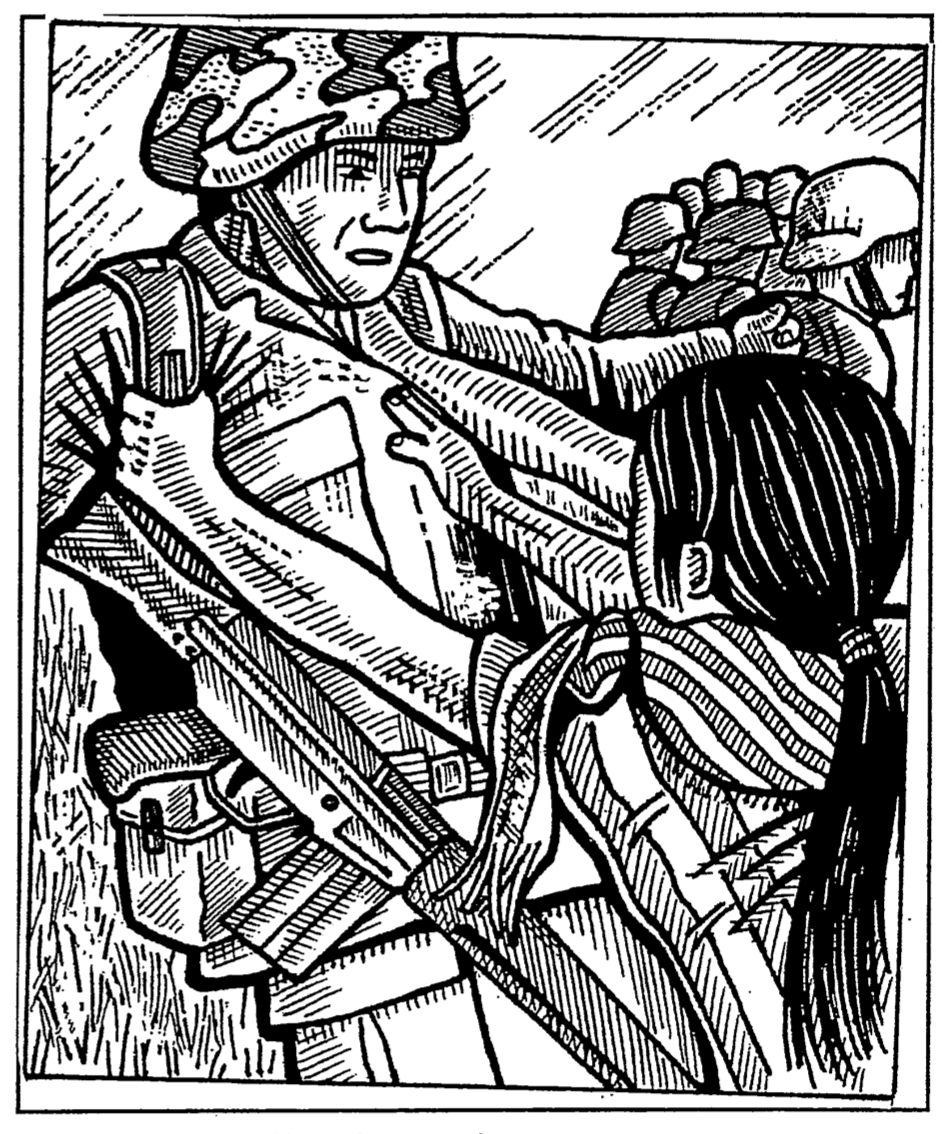
"Colonial exploitation, poverty, and endemic famine drive the native more & more to open organized revolt. The necessity for an open and decisive breach is formed progressively and imperceptibly, and comes to be felt by the great majority of the people. Those tensions which hitherto were non-existent come into being. International events, the collapse of whole sections of colonial empires and the contradictions inherent in the colonial system strengthen and uphold the native's combativity while promoting and giving support to national consciousness."
-- (Frantz Fanon, Wretched a/the Earth, p. 238)
Decolonization, the liberation of an oppressed & colonized people, must ultimately mean the liberation of land & territory. Just as colonialism occurs in ways unique to each situation, so too does decolonization. When we consider this process in regards to our own
situation in North America, it becomes clear that decolonization will be far different than other anti-colonial liberation struggles. It will more closely resemble the collapse of an empire, arising from both external & internal
factors. History has many examples of the decline and collapse of imperial systems, including those of the Romans and the Union of Soviet Socialist Republics (USSR).
Decline of the Roman Empire
Ancient Rome, which once ruled from Western Europe to North Africa, rose & collapsed within the span of just over 1,000 years. The period of its greatest expansion into an empire was during 200 AD to 400 BC, a period of just 600 years. In the end, it collapsed due to overextension of its military forces, political corruption & instability, internal social decline & rebellion.
More police & repressive laws failed to stop ongoing revolts by slaves, peasants, and colonies, while more soldiers sent to the frontiers could not stop growing tribal insurgencies (often led by war chiefs formerly trained by the Roman military).
The more imperial power Rome gained through conquest, the greater the wealth & privilege of its citizens. At the same time, the more it conquered, the more divided its society became as new colonized subjects & territories were
assimilated.
In the end, Rome faced both internal & external threats that converged to create a systemic breakdown. Rome itself was invaded, looted, and even occupied for periods of time by the same 'barbarian' tribes it had invaded & colonized.
Collapse of the USSR
In the 1970s, the USSR seemed all-powerful & monolithic. It was the second largest super-power next to the US, dominating eastern Europe and numerous 'client states' in Africa and Asia. In the 1980s, however, it was involved in a losing war in Afghanistan, which cost billions & demoralized much of the domestic population (just as Vietnam had done to the US). Soviet citizens became increasingly disillusioned with the political system, dominated by the corrupt Communist Party. The economy continued to decline as the country experienced a worsening ecological crisis. This resulted from widespread industrial pollution & waste, and included the 1986 Chernobyl nuclear power plant disaster. Entire regions & lakes were turned into deserts or wastelands. By 1991, these factors converged and lead to the collapse of the USSR, when many of the republics seceded & declared independence.
Decline of the USA
Today, the US dominates the global imperialist system, seemingly all-powerful. Nevertheless, it faces both internal & external threats not unlike those found in Rome, but on a far greater scale. Its military forces are spread around the world, in Europe, S. America, Africa, and Asia. Nearly 150,000 combat troops are presently deployed in Iraq & Afghanistan. On its southern border, poverty & exploitation have driven millions of Mexicans to immigrate into the US, while creating insurgent movements within Mexico itself.
Internally, the US is more polarized & divided than at any time since the Vietnam War (a period characterized by widespread rebellion & resistance). Many citizens have become increasingly disillusioned with the political system, ranging from leftists to right-wing 'Patriot' movements. The 2000 US presidential elections, which saw George W. Bush take power, are seen by many as the result of electoral fraud, in which millions of primarily African-American votes were disqualified in Florida.
Following the September 11, 2001, attacks on the World Trade Center and Pentagon, the US federal government immediately passed the USA PATRIOT Act and began forming a new Department of Homeland Security. At the same time, it launched its 'War on Terror', consisting first of the invasion of Afghanistan, followed by Iraq in 2003.
The Patriot Act & Department of Homeland Security have established a domestic police state, a trend set in motion with the 1960s-70s period of domestic counter-insurgency. Today, this police state has established broad, sweeping new powers for police, FBI & intelligence agencies to carry out surveillance, arrests, secret trials, and deportations. Hundreds of primarily Arab nationals remain in jails across the country, while colour-coded 'terror alerts' continue to be issued by Homeland Security, at times consisting of border closures and the deployment of heavily-armed police in major cities ('Hercules' teams).
These 'internal security' measures have further polarized US society, with growing numbers of citizens beginning to question the entire premise of a 'War on Terror', and in particular the US invasion of Iraq, which was based on falsified evidence of weapons of mass destruction and Iraq's ties to al-Qaeda. Despite extensive propaganda campaigns, disillusionment and cynicism continue to grow.
An Empire Divided
Poverty, drugs, crime, and police repression, continue to increase throughout the US, creating greater social tension & conflict, based primarily on racist oppression. In 1970, the number of persons in US federal or state prisons was around 200,000. Over the last 30 years, this number has increased to over 2 million, some 65 % of which are black, and 25 % Latino.
Blacks in the US have been a major catalyst for domestic resistance since at least the 1950s (i.e., the civil rights struggle, Martin Luther King, Malcolm X). During the 1960s, the black liberation movement (i.e., the Black Panthers) was also a major contributor to social rebellion within the US. This is due to the racist oppression of US society and the size of the black population itself (primarily urbanized).
According to the US Census Bureau, there are approximately 300 million US citizens. African-Americans comprise some 36 million, or 15 %. Mexicans, Chicanos and immigrants from Central America (referred to as Latino/as) comprise some 40 million, or 18 % of the total population. They are the fastest growing population in the US (in the 1950s they were an estimated 5 million). There are also an estimated 10 million undocumented 'immigrants' in the US, most from Mexico. Indigenous peoples (not including the Mexica nation) are an estimated 2 million.
Combined, these colonized peoples are some 85 million, over 30% of the entire population. Added to this are millions of Asian & Arab immigrants, many of whom are also impoverished and subjected to racist oppression. The great potential for revolt of this oppressed underclass can be seen in the rebellions of the 1960s-70s (primarily urban blacks), and again in 1992, when major cities saw large-scale rioting after the Rodney King trial in Los Angeles (multinational).
Throughout the 1990s, there was an overall renewal of rebellion in North America, beginning with the 1990 Oka Crisis in Canada; the 1992 LA riots; the 1994 Zapatista uprising in Mexico, and; the 1999 anti-WTO riots in Seattle. In 1993, US federal agents massacred over 80 men, women and children at Waco, Texas. All of these events had major social impacts and revealed the growing potential for revolt throughout society (even within elements of the white 'settler population).
Despite these sporadic rebellions & confrontations, it is difficult to conceive of mass organized resistance to the system here in North America under present social conditions. In fact, the situation appears counter-revolutionary and ultimately hopeless. Imagine organizing revolution in Babylon, 'cuz that's what we're trying to do.
It is therefore necessary to broaden our analysis. The most important observation is that the vast majority o f the world's population are oppressed & impoverished by the global system, in South & Central America, Africa, and Asia. In these regions we find not only conditions of extreme exploitation, but also a far higher level of resistance & struggle.
These struggles have an enormous impact on the imperialist system, creating economic uncertainty, limiting corporate access to resources, and requiring massive amounts of military
aid or intervention (War on Drugs, War on Terror).
Mexico and the US Southwest
In Mexico, the Zapatista rebellion has had a profound effect on Mexican society after 10 years of struggle. It has renewed the fighting spirit of Indigenous peoples and unified many diverse social movements. The Zapatistas have also established autonomous zones in Chiapas, based on principles of political autonomy and self-organization. It has promoted the role and status of women in Mexican society. In several Mexican states, over a dozen new guerrilla movements have emerged.
These factors have caused increasing concern for US authorities, which has supplied the Mexican state with funding, training, and new military equipment in order to wage counter-insurgency
warfare (most under the pretext of the War on Drugs).
Foremost among US concerns is the threat of economic disruption posed by Mexican insurgents, as well as the danger of contagion and the spreading of Mexico's revolutionary & insurgent culture within the US domestic population. During the Mexican Revolution in 1917, some 35,000 US troops were placed on the border to stop immigration.
Following the '94 Zapatista rebellion, the US intensified efforts to seal off its southern border. The INS greatly expanded its Border Patrol, increasing from 980 agents in 1994 to 2,264 in 1998. The INS annual budget nearly tripled- from $1.5 billion to $4.2 billion during the same period.
The result has been the creation of a militarized zone along the US-Mexico border, with joint police-military operations, checkpoints on roads and highways, constant patrolling, use of floodlights to illuminate areas, etc. Along with racist anti-immigrant laws, the result of this official policy has been a substantial increase in human rights violations. INS prisons have also increased their daily capacity from 8,279 in 1996, to 20,000 by 2001 (each year some 200,000 persons are detained by the INS).
Mexico, and by extension the US southwest, is clearly a strategic point to which our enemy devotes considerable resources. The Mexican population, both in Mexico and the US southwest, are seen as hostile and dangerous. Despite this, Mexicanos are a large and necessary part of US society, serving as a highly exploitable source of manual labour. Like New Afrikans, the Mexica/Chicano peoples are a strategic factor in decolonization.
Insurgency in Iraq
Today, one of the most critical regions for US imperialism is the Middle East and, in particular, its oil & gas resources. This region alone contains two-thirds of all known petroleum supplies, and is vital to the Western industrial system as a whole. European nations, as well as those in Asia (i.e., China), are increasingly dependent on these supplies. US plans for global domination requires direct control of Mid-East oil; whoever controls this region exercises control over the global system itself. For this reason, the US invasion of Iraq has not been supported by most European nations, who see it as an attempt by the US to assert control while undermining their own positions.
Faced with a growing insurgency in Iraq, the US is now involved in a war from which it cannot simply withdraw, but which, ultimately, it cannot win. As Vietnam showed, large segments of the US population are unwilling to support wars of this nature and are far less loyal to the system than during World Wars 1 & 2. As economic conditions continue to decline, the US will experience increasing social conflict from within, while resistance in the Middle East and other regions will also expand, requiring ever-greater deployment of police & military forces.
As noted, US society is deeply divided by race, and this is reflected in its military forces. African, Asian, and Indigenous/Latino peoples comprise a disproportionate number of frontline combat troops (and therefore casualties). During Vietnam, racism in the US military contributed to a culture of mutiny, desertion, and even the killing of commanders seen as racist or willing to sacrifice troops ('fragging'). US troops were also demoralized by their inability to stop guerrilla attacks, mounting casualties, widespread drug use, and the blatant injustice oftheir actions.
Already, US troops in Iraq have become demoralized and disillusioned with their mission. Many citizens have come to question the legitimacy of the war itself. Within months of the invasion, the largest anti-war demonstrations occurred around the world. Not until the late sixties, almost 5 years after escalating US involvement, were there similar mass demonstrations against the Vietnam War. As casualties continue to mount, US public opinion is increasingly turning against the occupation of Iraq, threatening to further polarize US society.
Crises, Conflict and Resistance Potential
The global environment is rapidly deteriorating due to industrial pollution & resource depletion. Global warming is already causing extreme weather patterns, including storms, droughts, deadly heat waves, bug infestations, forest fires, melting of polar ice caps & glaciers, etc., all of which have negative effects on the global economic system.
Within the G7, globalization and neo-liberal trade policies have shifted large amounts of industrial production to 'less-developed' countries, where labour & resources are far cheaper. This has resulted in growing unemployment within the most industrialized nations.
Despite decades of economic growth, poverty has expanded around the world and within the G7 nations themselves. Only the rich and certain middle-class sectors have benefited from the process of globalization (another term for imperialism). Today, overall economic and social conditions are worse than in the 1960s, a decade that saw widespread social rebellion.
The convergence of war, economic decline, & ecological crises will lead to greater overall social conflict within the imperialist nations in the years to come. It is this growing conflict that will create changes in the present social conditions, which will create greater opportunities for organized resistance. The rulers are well aware of this, and it is for this reason that state repression is now being established as a primary means of social control (i.e., greatly expanded police- military forces, new anti-terror laws, etc).
As these crises deepen, the system becomes more & more vulnerable. When colonial or imperial systems weaken, this has been the time at which colonized nations have advanced. We can see this in ancient Rome, in the post-WW2 period, and in the collapse of the USSR.
If this analysis is correct, we are now in a period that can be described as the "calm before the storm", a storm that will eventually shake the very foundations of the imperial system itself: It is this growing potential for social conflict & systemic breakdown that provides the best possibility for decolonization, at both national & international levels.
Bibliography
- American Holocaust; the Conquest of the New World, by David E. Stannard, Oxford University Press, New York 1992
- The Conquest of America, by Hans Koning, Monthly Review Press, New York 1993
- The West and the Rest of Us; White Predators, Black Slavers & the African Elite, by Chinweizu, Random House, NY 1975
- The Wretched ofthe Earth, by Frantz Fanon, Grove Weidenfeld, NY 1968
- Settlers; the Mythology of the White * Proletariat, by J. Sakai, Morningstar Press, Chicago 1989
- 500 Years ofIndigenous Resistance, by Gord Hill, Arm the Spirit/Solidarity, 2002
- First Nations in Canada; Perspectives on Opportunity, Empowerment, and self-Determination, by J. Rick Ponting, McGraw-Hill Ryerson Ltd., Toronto 1997
- Trust After Trauma; A Guide to Relationships for Survivors and Those Who Love Them, by Aphrodite Matsakis, Ph. D, New Harbinger publications, Oakland Ca 1998
- Tortured People; The Politics of Colonization, by Howard Adams, Theytus Books, Penticton, 1999
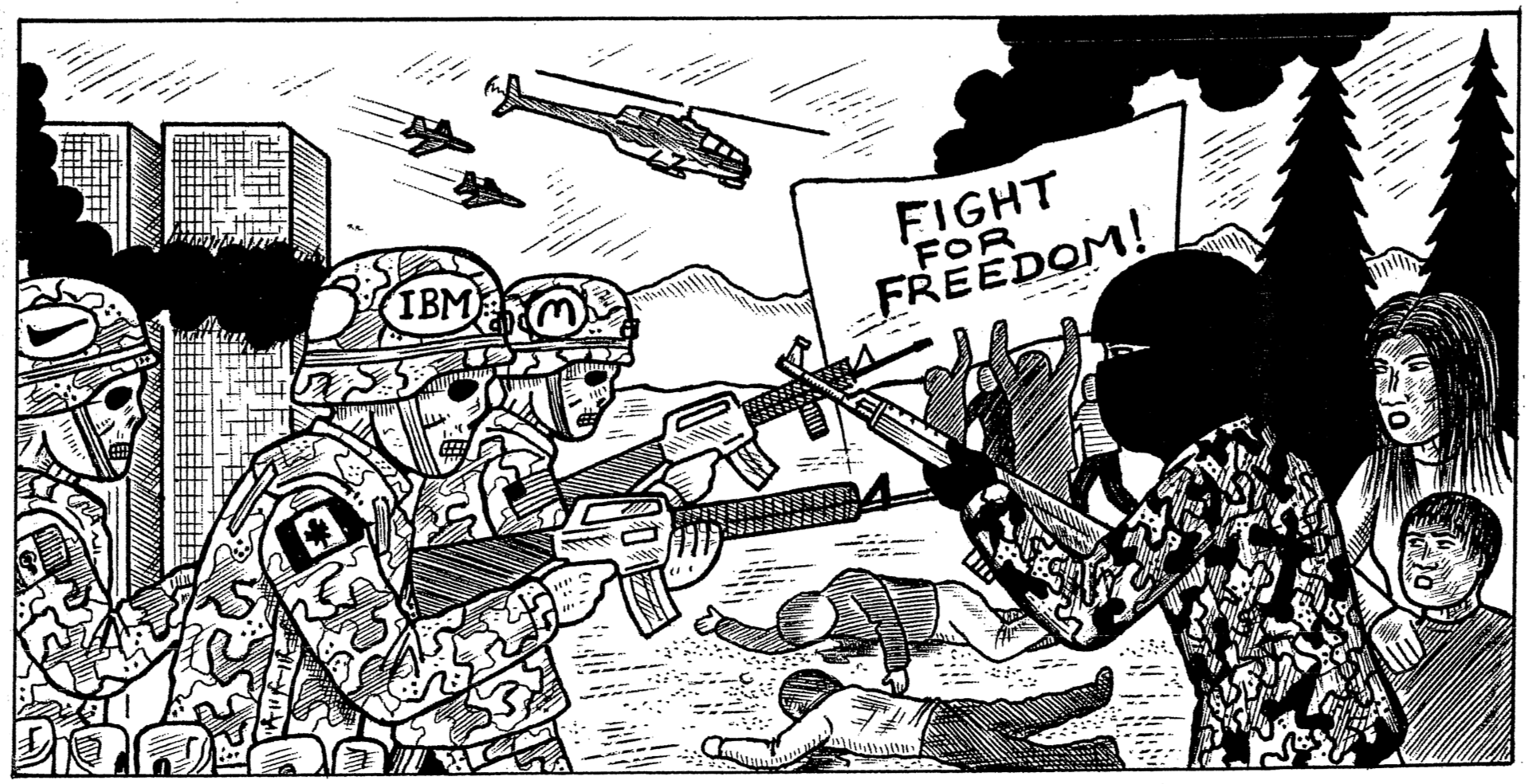
Note: the purpose of these appendices is not to promote the United Nations, but rather to show the hypocrisy of colonial states and a global system that claims to stand for human rights, peace & freedom.
Appendix A
UN Declaration on Decolonization
Declaration on the Granting of Independence to Colonial Countries and Peoples Adopted by General Assembly resolution 1514 (XV) of 14 December 1960
The General Assembly,
Mindful of the determination proclaimed by the peoples of the world in the Charter of the United Nations to reaffirm faith in fundamental human rights, in the dignity and worth of the human person, in the equal rights of men and women and of nations large and small and to promote social progress and better standards of life in larger freedom,
Conscious of the need for the creation of conditions of stability and well-being and peaceful and friendly relations based on respect for the principles of equal rights and self-determination of all peoples, and of universal respect for, and observance of: human rights and fundamental freedoms for all without distinction as to race, sex, language or religion,
Recognizing the passionate yearning for freedom in all dependent peoples and the decisive role of such peoples in the attainment of their independence,
Aware of the increasing conflicts resulting from the denial of or impediments in the way of the freedom of such peoples, which constitute a serious threat to world peace,
Considering the important role of the United Nations in assisting the movement for independence in Trust and Non-Self-Governing Territories,
Recognizing that the peoples of the world ardently desire the end of colonialism in all its manifestations,
Convinced that the continued existence of colonialism prevents the development of international economic co-operation, impedes the social, cultural and economic development of dependent peoples and militates against the United Nations ideal of universal peace,
Affirming that peoples may, for their own ends, freely dispose of their natural wealth and resources without prejudice to any obligations arising out of international economic co-operation, based upon the principle of mutual benefit, and international law,
Believing that the process of liberation is irresistible and irreversible and that, in order to avoid serious crises, an end must be put to colonialism and all practices of segregation and discrimination associated there with,
Welcoming the emergence in recent years of a large number of dependent territories into freedom and independence, and recognizing the increasingly powerful trends towards freedom in such territories which have not yet attained independence;
Convinced that all peoples have an inalienable right to complete freedom, the exercise of their sovereignty and the integrity of their national territory,
Solemnly proclaims the necessity of bringing to a speedy and unconditional end colonialism in all its forms and manifestations; And to this end Declares that:
- The subjection of peoples to alien subjugation, domination and exploitation constitutes a denial of fundamental human rights, is contrary to the Charter of the United Nations and is an impediment to the promotion of world peace and co-operation.
- All peoples have the right to self-determination; by virtue of that right they freely determine their political status and freely pursue their economic, social and cultural development.
- Inadequacy of political, economic, social or educational preparedness should never serve as a pretext for delaying independence.
- All armed action or repressive measures of all kinds directed against dependent peoples shall cease in order to enable them to exercise peacefully and freely their right to complete independence, and the integrity of their national territory shall be respected.
- Immediate steps shall be taken, in Trust and Non-Self-Governing Territories or all other territories which have not yet attained independence, to transfer all powers to the peoples of those territories, without any conditions or reservations, in accordance with their freely expressed will and desire, without any distinction as to race, creed or colour, in order to enable them to enjoy complete independence and freedom.
- Any attempt aimed at the partial or total disruption of the national unity and the territorial integrity of a country is incompatible with the purposes and principles of the Charter ofthe United Nations,
- All States shall observe faithfully and strictly the provisions ofthe Charter ofthe United Nations, the Universal Declaration of Human Rights and the present Declaration on the basis of equality, non-interference in the internal affairs of all States, and respect for the sovereign rights ofall peoples and their territorial integrity.
Appendix B
Excerpts from: 1948 United Nations Genocide Convention
The Contracting Parties,
Having considered the declaration made by the General Assembly of the United Nations in its resolution 96(I) dated 11 December 1946 that genocide is a crime under international law, contrary to the spirit and aims of the United Nations and condemned by the civilized world;
Recognizing that at all periods of history genocide has inflicted great losses on humanity; and Being convinced that, in order to liberate mankind from such an odious scourge, international co-operation is.required,
Hereby agree as hereinafter provided:
ARTICLE 1
The Contracting Parties confirm that genocide, whether committed in time of peace, or in time of war, is a crime under international law which they undertake to prevent and to punish.
ARTICLE 2
In the present Convention, genocide means any ofthe following acts committed with intent to destroy, in whole or in part, a national, ethical, racial or religious group as such:
(a) Killing members ofthe group;
(b) Causing serious bodily or mental harm to members ofthe group;
(c) Deliberately inflicting on the group conditions of life calculated to bring.about its physical destruction in whole or in part;
(d) Imposing measures intended to prevent births within the group;
(e) Forcibly transferring children of the group to another group.
ARTICLE 3
The following acts shall be punishable:
(a) Genocide;
(b) Conspiracy to commit genocide;
(c) Direct and public incitement to commit genocide;
(d) Attempt to commit genocide;
(e) Complicity in genocide
ARTICLE 4
Persons committing genocide or any of the other acts enumerated in Article 3 shall be punished, whether they are constitutionally responsible rulers, public officials or private individuals.
End of Excerpt
